Clubs grapple with Title IX retaliation policy
Policies prevent clubs from expelling alleged assailants
BY BRIAN ZHANG & INES CHOMNALEZ STAFF REPORTERS
Content Warning: This article contains references to sexual violence.
SHARE is available to all members of the Yale community who are dealing with sexual misconduct of any kind, including sexual assault, sexual harassment, stalking, intimate partner violence and more. Counselors are available any time, day or night, at the 24/7 hotline: (203) 432-2000.


In her first semester at Yale, A. tried out for the University’s Mock Trial Association, looking for an opportunity to build stronger relationships with peers following a di cult transition from high school.

As part of her try-out process, she attended a virtual rush meal with current YMTA members.
It was there that she first made contact with a male student who was then a sophomore in the organization — someone who A. alleges would go on to repeatedly sexually assault her over the following months. The male student did not respond to requests for comment.
“Those experiences have forever changed who I am,” A., a female student who has been granted anonymity to protect her privacy, told


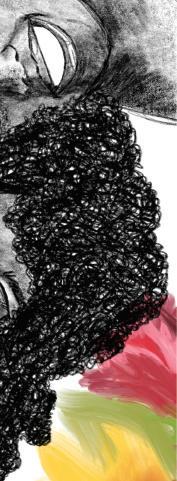
A Benjamin Franlin student was arrested and escorted from the college
BY NATHANIEL ROSENBERG & EVAN GORELICK STAFF REPORTERS
A student in Benjamin Franklin college was arrested last Wednesday after Yale Police found a handgun and illegal drugs in their dorm room.
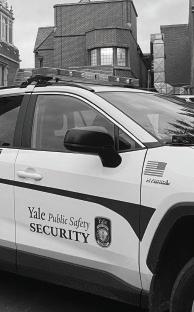
Students gathered on Cross Campus to protest new housing process
BY KAITLYN POHLY & TRISTAN HERNANDEZ STAFF REPORTERS
“What do we want?” “Accommodations!” “When do we want them?” “Now!” On Wednesday, Feb. 22, these words could be heard from student protestors on Cross Campus.
Religious student groups — including the Muslim Students Association, the Southeast Asian Students Society and Ya’aleh — held the rally to protest the new streamlined housing system that does not formally guarantee religious housing accommodations.
Speakers recounted challenges they faced without accommodations and encouraged passers-by to sign a petition to call on Yale to formalize requests for these religious accommodations, which had previously been left to the discretion of residential college deans and the Yale Chaplain’s O ce. So far, the petition has over 350 individual student signatures as well as signatures from over 60 student organizations such as the Yale College Council and Yale College Democrats.
“We’re calling on Yale to recognize and guarantee religious housing accommodations in the new housing system by instituting a formal process for requesting these accommodations,” Inssia Ahmed ’25 said on the steps of Sterling Memorial Library to a crowd of assembled students.
Yale College students were notified of the arrest Tuesday in an email from Yale Police Chief Anthony Campbell and Associate Vice President for Public Safety & Community Engagement Ronnell Higgins. The email offered a rough timeline of events as well as YPD’s reasoning for the arrest.
In their joint email, Higgins and Campbell wrote that YPD responded to a report of a student threatening to harm another student and potentially possessing a firearm. YPD obtained a warrant, searched the student’s room and arrested the student without incident.
“During the investigation, officers found an unloaded handgun, significant quantities of a controlled substance, illegal drugs, and evidence of additional drug-related activity,” the email read. “The student was placed in custody without incident, and Yale Police confiscated the handgun. Criminal charges are being considered for several drug offenses.”

The email also stated that the arrested student was no longer enrolled at Yale, but Campbell did not clarify whether the student was expelled or if the student
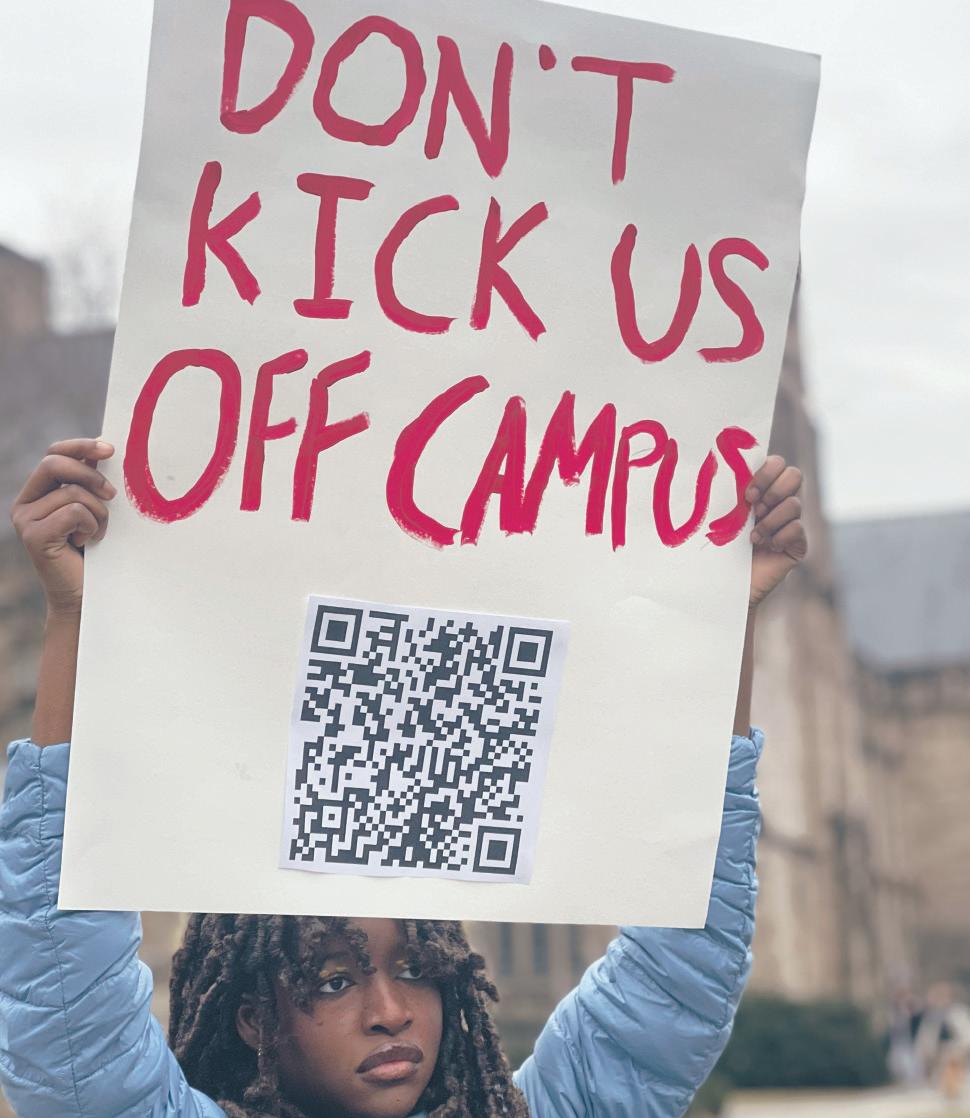 BY TRISTAN HERNANDEZ STAFF REPORTER
BY TRISTAN HERNANDEZ STAFF REPORTER
The Whiffenpoofs and Whim ’n Rhythm — Yale’s two all-senior a cappella groups — announced their newest taps on Monday evening.
Auditions for both groups took place Feb. 16 through Feb. 19, with students with one to three semesters left at Yale eligible to audition. The News spoke to seven incoming Whiffs and Whims about their induction to the groups.
“I'm super excited to be the new music director and am honored to have been chosen by the current Whi s,” Peter Sykes ’24 said. “It honestly didn't feel real at first, I'm just thrilled and so grateful to have this opportunity. I'm sure it will be a lot of work, but I'm excited to take on this new challenge.”
Whiffenpoofs and Whim ’n Rhythm are both known for their selectivity,
speaks at
Recounts a life of songwriting at talk on campus
BY YASH ROY & EVAN GORELICK STAFF REPORTERS
Thousands came together on Thursday evening to hear Sir Paul McCartney speak about his new book, “The Lyrics: 1956 to the Present.”
The conversation included Pulitzer Prize-winning poet Paul Muldoon, who edited McCartney’s book, and was moderated by Yale English professor Langdon Hammer. More than 2,500 people from Yale and the broader community attended the event in Woolsey Hall.
McCartney — who holds an honorary degree from Yale and whose grandson, Arthur Donald ’21, attended Yale — recounted his songwriting career at the event. He wrote 154 songs throughout his life, including unreleased tracks predating his time in the Beatles that appear in “The Lyrics.” During Thursday’s talk,
INSIDE THE NEWS
C ROSS C AMPUS YALE SECURITY OFFICERS SIGN 5-YEAR CONTRACT PAGE 7 NEWS THIS DAY IN YALE HISTORY, 1993. After losing running water and using porta-potties for 36 hours, Davenport and Pierson finally regain heating and plumbing once repairs are made to a burst pipe in Pierson tower. McCartney
Schwarzman UKRAINE A YSPH study has revealed Russian re-education programs for Ukrainian children. PAGE 8 SCITECH "IF PRETTY HURTS" Undergraduates open sold-out play at Yale Repertory Theatre. PAGE 9 ARTS PAGE 3 OPINIONS PAGE 6 NEWS PAGE 13 BULLETIN PAGE 11 SPORTS PAGE B1 SPISSUE Title IX was of the Civil Rights Act was signed into law by President Richard Nixon on June 23, 1972 / Tim Tai, Photography Editor SEE MCCARTNEY PAGE 5 Black History Month Special Issue NEW HAVEN, CONNECTICUT FRIDAY, FEBRUARY 24, 2023 VOL. CXLV, NO. 16 yaledailynews.com · @yaledailynews THE OLDEST COLLEGE DAILY FOUNDED 1878 SEE FIREARM PAGE 5 YPD finds firearm, illegal drugs in dorm SEE HOUSING RALLY PAGE 4 Speakers recounted challenges they faced without accommodations and encouraged passers-by to sign a petition to call on Yale to formalize requests for these religious accommodations. / Kaitlyn Pohlly, Contributing Photographer Whi enpoofs and Whim ’n Rhythm
classes Rally for religious housing accomodations Page S1 SEE ACAPELLA PAGE 4 SEE TITLE IX PAGE 4
tap 2024
ACROSS
1 Band of "In the heat of the moment"
5 East Coast, Lindy, etc.
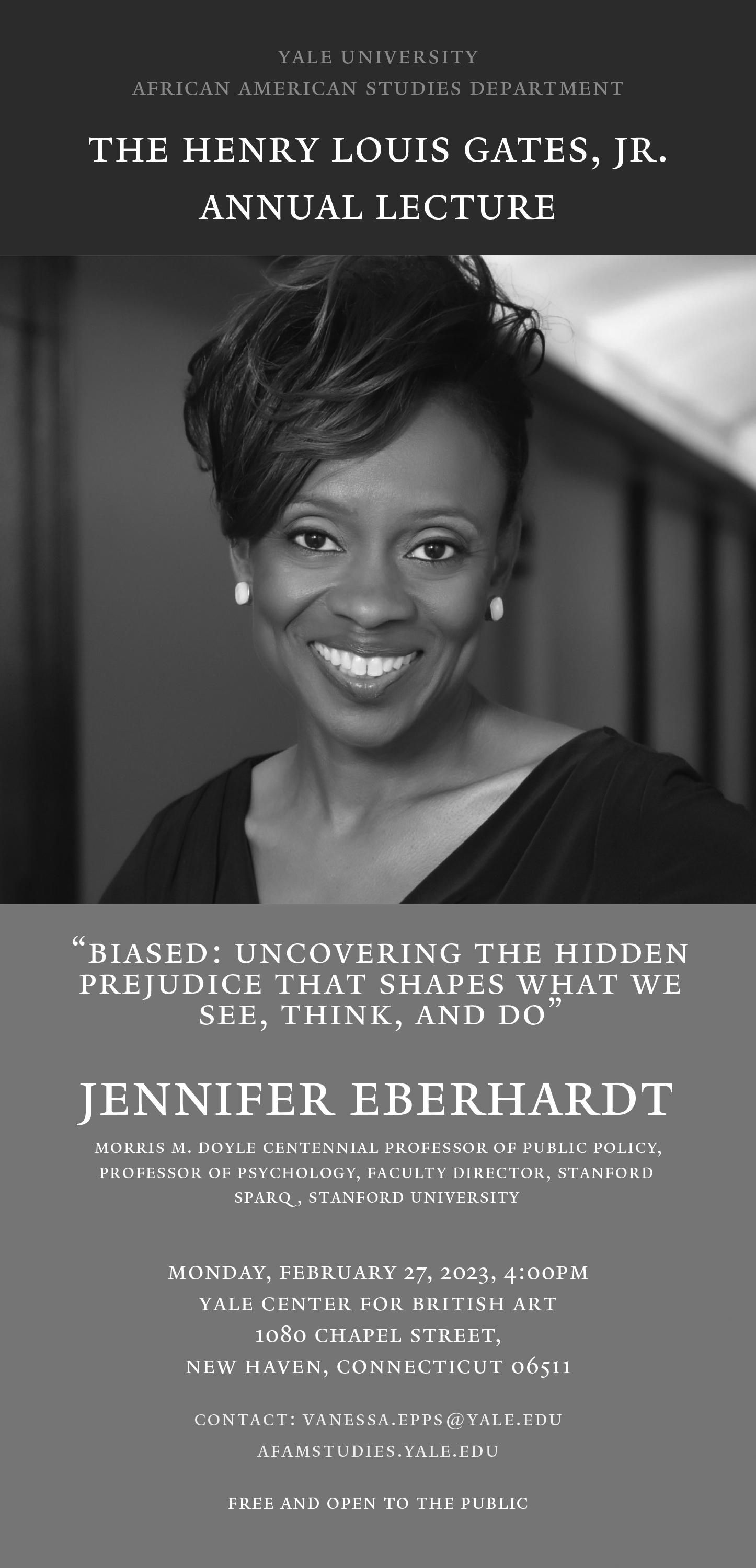
6 Classically Argentine dance
7 Element with 18 electrons
8 High-maintenan ce
DOWN
1 In the know
2 Just a bit of burning
3 Who dollar bills trust
4 This can cut like a knife
5 A diehard fan
Crosswords by Avery Long
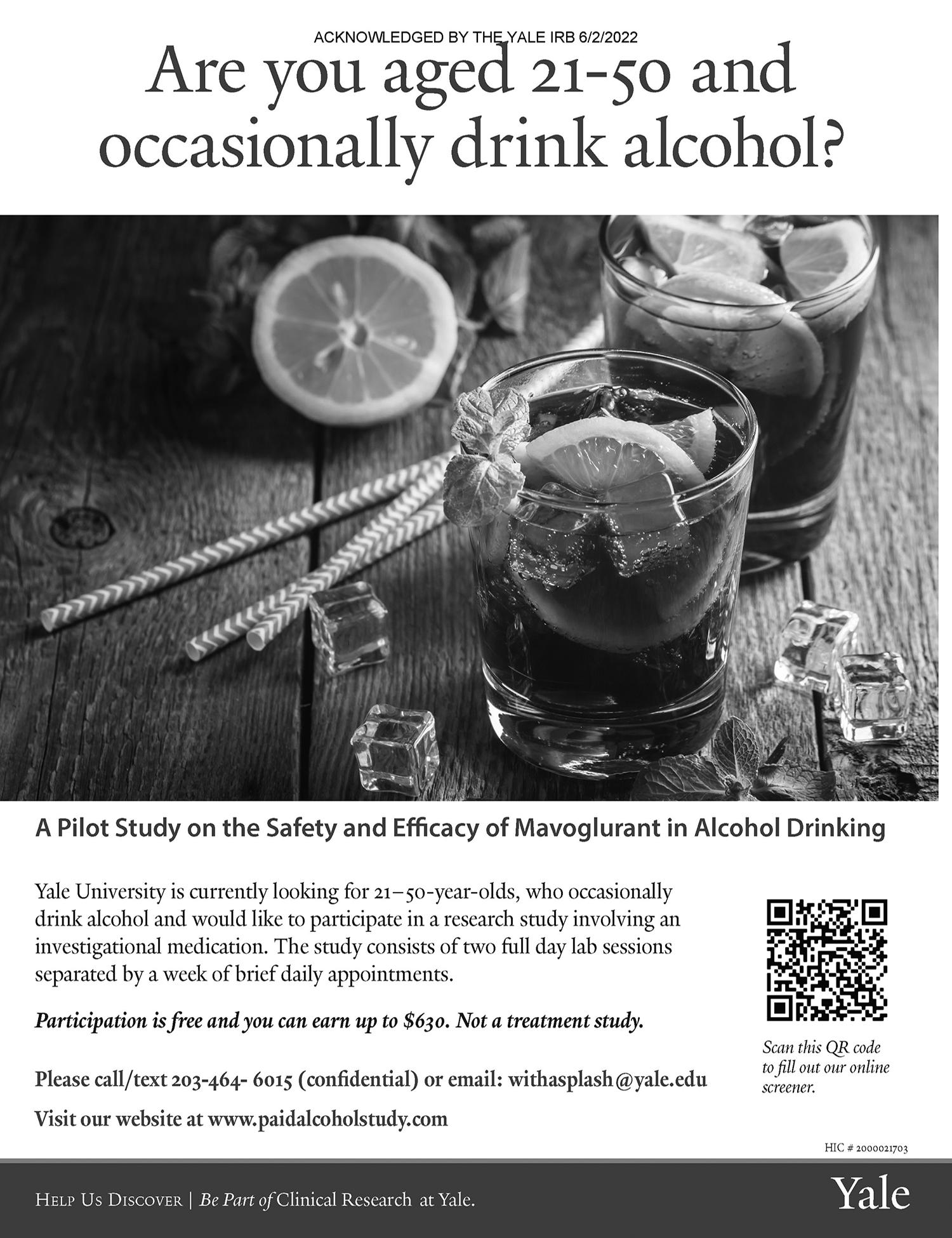
BULLETIN PAGE 2 YALE DAILY NEWS FRIDAY, FEBRUARY 24, 2023 yaledailynews.com Last week’s answers:
week’s crossword: Mini 5 P A 3 U L 5 V O L V O 6 A R G U S 7 S C A L E 8 H E A R ACROSS 1 Not to be confused with Mr. Goodman 5 Swedish auto company 6 Giant who was bored to death 7 Maps are not to this 8 Detect a "polo," for instance DOWN 1 Place to sit, swing, or chat 2 Blooms are detrimental 3 Dangler at the back of the mouth 4 Dweeb, twerp, etc. 5 On-y-...
1 2 3 4 5 6 7 8
This
Mini 6
OPINION
Yale, it’s time to rethink Eli Whitney





A Yale School of Management experience is incomplete without a photo beside the “Yale School of Management 165 Whitney Ave” sign in front of the building. And it’s not just SOM students: recent grads, newly accepted students, families and visitors stop for a selfie, quick pose and even a professional photoshoot. The striking modern aesthetic of Evans Hall makes for great photos, and the sustainable design complements SOM’s mission to educate leaders for business and society. Yet, for every photo taken by the SOM sign, there is a reminder of the history of Eli Whitney and the Whitney family.
Eli Whitney began his studies at age 24 and graduated from Yale three years later, in 1792. Two years later, Eli Whitney patented the cotton gin, cementing his legacy. He is also famous for first pioneering manufacturing techniques, creating uniform processes and designing interoperable parts for his gun armory in Hamden. Dubbed Whitneyville, it was one of the first factory compounds in the country that inspired factories decades after that.
His son, Eli Whitney, Jr., continued the family business and sold tens of thousands of rifles and handguns to the federal government and state militias. Although born in New Haven, he attended Yale before transferring to Princeton, where he graduated.
After college, he returned to New Haven to manage the armory and developed the Whitneyville Colt revolver. Later, he was pivotal in developing the fi rst water utility for New Haven. It is impossible to separate New Haven and America’s early industrialization from the Whitney family.
The proliferation of the cotton gin, short for “engine,” led to the South becoming the global leader in cotton production. Eli Whitney believed the cotton gin would reduce dependence on slavery. Tragically, the invention tripled the demand for enslaved labor, grew Southern wealth and exacerbated America’s political, social and economic divisions. Although the cotton gin was ultimately not profitable to Eli Whitney due to weak intellectual property protections, his gun manufacturing business was profitable and supported the federal government’s westward expansion.
His son’s most famous invention, the Whitneyville Colt revolver, was used by Texas Rangers, who actively fought Native Americans in Texas and the Mexican-American War. Although he developed the first water utility for New Haven, his chief concern was supplying his armory with additional power. His sizable stake in the water company grew his wealth, and he used the water to create a company serving the city’s iceboxes with access to the water. The water enabled him to improve and
consolidate the armory. With a lucrative water business, the grandson sold the armory in 1888. Eli Whitney, Jr. passed away in 1894.
The Whitney Family’s impact on American history is to be studied, not celebrated. The cotton gin, the Colt revolver and the Whitney family’s business practices do not represent the best of Yale. The University can and must do better. Yale should rethink marketing Eli Whitney for its academic programs and support renaming Whitney Avenue along campus, which includes SOM and Science Hill. Yale’s centuries-long history is brimming with candidates who can serve this role.
One of the benefits of being a Yalie is learning about the University’s 321-year history. Some of my favorites include the birth of neuroscience and the Cushing Center’s display of human brains, a statue of Yung Wing, the first Chinese person to graduate from a university in North America in 1854, the extra-wide wooden seat in Woolsey Hall made for the extrawide President Taft in 1913, the first doctorate awarded in North America in 1861 and to an African American, Edward Bouchet in 1876.
The story of Edward Bouchet is remarkable. His father was enslaved to a Yale student, who brought him to New Haven from Charleston, SC, and freed him upon graduation, as the State of Connecticut had a gradual abolition law that took full e ect by 1848. His father became a “sweeper” — custodial sta — for the University and was active in the community. Edward excelled at science and later graduated valedictorian in high school. He was sixth out of 124 in his class at Yale, becoming one of the first African Americans to graduate from Yale. Edward returned to Yale to earn a doctorate in Physics, the first African American in the US to earn a doctorate., in 1876. Employment opportunities were minimal, and he taught science at a segregated high school with few resources. The school later cut his program and job to provide only vocational classes. He retired in New Haven and died in 1918.
The Yale & Slavery Research Project concluded its work last year by illuminating some of the histories of “sweepers,” among others, through featured research, conferences and events. However, the Project did not address the role of the Whitney family and Yale’s current use of the Whitney name to promote academic programs. Yale should keep Eli Whitney in the history books but publicly celebrate those who represent the ethos of the University. Bouchet Avenue is a step in the right direction.
ROBERT
No school is safe
In February of 2018, I wrote an op-ed for the Seattle Times, titled “‘It could have been us:’ 3,000 miles from Florida, a 14-year-old’s plea.” I wrote that I could “see myself there, because Marjory Stoneman Douglas High School [was] just like mine: big, sprawling, packed with kids who I know are struggling, kids who have been told the adults will keep them safe from harm, adults who tell them it will never happen here.” It ran in the Sunday paper, alongside a piece by Washington State Attorney General Bob Ferguson pushing for Washington lawmakers to vote on assault-weapons limits. I was on the local news, and received letters – and hate mail – from readers all over the Pacific Northwest. Five years ago, I wrote that “change needs to be turned in not tomorrow, but today.”

But now – following the five-year anniversary of the mass shooting enabled by nonexistent assault weapons laws that took seventeen fourteenyear-olds who would be sophomores in university, just as myself, as you, as your peers, and the students you teach – three students at Michigan State University are dead. They are Arielle Anderson, a pre-med student who wanted to be a surgeon, Brian Fraser, president of Michigan State’s
Phi Delta Theta fraternity, and Alexandria Vernier, the multisport athlete described by her high school superintendent as “an amazing girl that doesn’t come around that often.” I spend my school night not reading for my art history class, nor writing a lighthearted piece for the News’ WKND section, but about the same anger I wrote about five years ago, now a chilling terror that begets no descriptors. Arielle was 19, Brian and Alexandria 20. Three more peers – one campus reels, while others move on, mourning their own profound losses.
I HAVE WRITTEN TO MY FAMILY FROM A PLACE THEY HAVE SENT ME TO LEARN ABOUT THE WORLD, REASSURING THEM THAT THE WORLD HAS NOT HURT ME. THIS TIME.
I have written about “shellshock putting me on my knees.”
I have written that my education on gun control in America in the years following the Marjory Stoneman Douglas shooting “has been enough,” and that February 14th, 2018 was the day my childhood ended and adulthood began. I have written that “all I feel is the bone-rattling panic that comes when someone’s youth is crumpled between the bony palms of a scary world.” I have walked out of class in protest, but now I am not just afraid to walk alone at night. I have no emotions left.
Last year, it was a bomb threat at Yale and three other Ivy League campuses. This year, it was armed police storming Bingham Hall in the middle of the night. It is the weekly Yale Alerts and assaults of students just steps from dorm room entrances. It is paintball shooters and pellet guns and automatic weapons that are still legal to buy in much of the United States.
I have written to my family from a place they have sent me to learn about the world, reassuring them that the world has not hurt me. This time.
Today, I write that I cannot imagine a walk to class in which I am not afraid.
ANABEL MOORE is a sophomore in Branford College. Contact her at anabel.moore@yale.edu.
Growing pains


I rarely ever tell people what I’m majoring in. I much prefer to make them guess.
Most days, this strategy serves me well. The first time I wore the mustard yellow woolen sweater my mum bought me last December, I was told that I dress like a Humanities major. Given that my first ignorant winter in America involved pairing shirts, t-shirts and collared t-shirts with a rotating collection of dark gray sweatpants, the compliment was a validation of sartorial progress.
Last week, a close friend asked if I was a Political Science major, because I seem to care about “what’s going on with the world.” Though I disagreed with his generously short yardstick, I took that as a compliment as well. And then, there was the racist old lady who saw me bedecked in a Yale sweatshirt in an art gallery in Florida and asked, “do-you-go-to-Yaleand-also-do-you-study-computer-science,” in the same runaway breath. I’m only grateful she didn’t ask to meet my 78 cousins, my pet cow or the fictive helicopter parents who have been planning my arranged marriage since I was six.
My aversion to talking about my major makes for more than a litmus test of my academic aesthetic, or even the first impressions I unknowingly cultivate. It is also the reason that a close friend didn’t realize I was double majoring in MB&B, along with the Humanities. It seems that my loud, constant praises of Walter Benjamin and my penchant for unnecessarily using the word “Kantian” concealed my appreciation for cell papers describing how mutations of the xDFG motif for CDK11B affect OTS964 sensitivity. Even so, I would be lying if I said his innocence did not make me happy. It felt like the validation of what I can only describe as an unconsciously concerted project to conceal my STEMness.
Before I am flooded by a deluge of messages from indignant friends majoring in Physics, I will clarify that I have loved my STEM education at Yale. MB&B Biochemistry core requirements have been some of my best taught and most collaborative classes. Critically reading scientific literature is one of the most useful skills I will graduate
with. And I’ve forged countless close friendships in the heat of Organic Chemistry II.
And yet, I rarely talk about my STEM classes. In fact, many of my conversations about science classes are better described as weekly diatribes about the length of yet another problem set. Humanities classes, on the other hand, generate endless conversation topics. Close friends are more likely to know the weekly reading list of my seminar on iconic consciousness and material culture than they are to know that I’m taking a physics lab class this semester. Accessibility certainly plays a role in this discrepancy.
Explaining the significance of a paper about a newly discovered Cas protein to a friend who does not know the difference between DNA and RNA is far more cumbersome than discussing Ralph Waldo Emerson’s individualism with a friend who has never read an Emerson essay. But I’d be remiss if I did not admit that such dissimulation is largely driven by self-perception.
There is a dearth of Indian men in the humanities, caused largely by an education system that overvalues STEM, relegating what is termed the “arts” to a gendered, underappreciated sphere. This culture percolated even into my high school’s IBDP program — an ostensibly “holistic” approach to education — in which numerous friends equated their mathematical prowess and their antipathy for literature with their vaunted intellectual superiority. Perhaps that is why I wear my predilection for the humanities on my sleeve. It is a badge of honor, an affirmation that I do not conform to the stereotypes others like to traffick in.
Most importantly, though, I have always feared being victimized by the analytical/creative binary with which so many Yalies like to conceive of the world. To admit I am also a STEM student is to invite comments from poetry professors about how I will be well-suited
to analyze the meter of a Miltonian verse. Scansion is well and good, but I would much rather focus on imagery.
In an academic environment in which buzzwords like “interdisciplinarity” and “different perspectives” populate every new paper on pedagogy and every class’s Canvas page, such a minor criticism can feel like a quibble. But to think that a STEM student is only a valuable addition to a humanities class because they will appreciate the metaphor of a “laboratory” that one uses to explain Zola’s construction of Therese Raquin, or to think that a humanities student can only be a good physicist because they will be most appreciative of the elegance of a proof, is to prove my point entirely.
It seems ludicrous to have to affirm that applied math majors can debate Hegel with the best of them and that there are English majors who are much better at retrosynthesis than I ever was. And shockingly, STEM and humanities double majors want to do more than write a thesis on Karl Popper. Some of them want to write two distinct theses — one on Russian realism and another on RNA biology.
When the language and anecdotes we use to extoll the virtues of interdisciplinarity is rife with subtext about the way people think, we reveal how easy it is to categorize people’s intellectual interests purely by major. Ironically, in a school whose disinclination to minors was meant to produce a graduating class of polymaths, the existence of single majors has lent itself especially well to intellectual stereotyping.
So let the English majors try to prove Fermat’s last theorem. Let the mathematicians debate Wilson’s analysis of Queer Harlem, Queer Tashkent: Langston Hughes’s “Boy Dancers of Uzbekistan”. And the Political Science, Economics and Global Affairs majors who I have not even considered? Let them eat cake.
PRADZ SAPRE is a junior in Benjamin Franklin College. His fortnightly column “Growing pains” encapsulates the difficulties of a metaphorical “growing up” within the course of a lifetime at Yale. He can be reached at pradz.sapre@ yale.edu.
NEW HAVEN, CONNECTICUT COPYRIGHT 2022 — VOL. CXLIV, NO. 29
LUCAS is a current MBA student in the Class of 2023 and former Kerry Fellow (2021-22). He can be reached at robert.lucas@yale.edu.
GUEST COLUMNIST ANABEL MOORE
YALE DAILY NEWS FRIDAY, FEBRUARY 24, 2023 yaledailynews.com PAGE 3
EDITORIALS & ADS The Editorial Board represents the opinion of 12-15 members of the Yale community. Other content on this page with bylines represents the opinions of those authors and not necessarily those of the Managing Board. Opinions set forth in ads do not necessarily reflect the views of the Managing Board. We reserve the right to refuse any ad for any reason and to delete or change any copy we consider objectionable, false or in poor taste. We do not verify the contents of any ad. The Yale Daily News Publishing Co., Inc. and its o cers, employees and agents disclaim any responsibility for all liabilities, injuries or damages arising from any ad. The Yale Daily News Publishing Co. ISSN 0890-2240 SUBMISSIONS All letters submitted for publication must include the author’s name, phone number and description of Yale University a liation. Please limit letters to 250 words and guest columns to 750. The Yale Daily News reserves the right to edit letters and columns before publication. E-mail is the preferred method of submission. ADVERTISEMENT (203) 432-2424 (before 5 p.m.) (203) 432-2400 (after 5 p.m.) Direct all letters, columns, artwork and inquiries to: Contact the Opinion Editors at opinion@yaledailynews.com Direct all comments regarding the fairness or accuracy of stories to: Lucy Hodgman Editor-in-Chief (203) 432-2418 Christian Robles Public Editors public@yaledailynews.com YALE DAILY NEWS PUBLISHING CO., INC. 202 York Street, New Haven, CT 06511 (203) 432-2400 Editorial: (203) 432-2418 editor@yaledailynews.com Business: (203) 432-2424 business@yaledailynews.com EDITOR IN CHIEF & PRESIDENT Lucy Hodgman MANAGING EDITOR Dante Motley Sylvan Lebrun PUBLISHER Olivia Zhang PUBLIC EDITOR Christian Robles INTERNAL AFFAIRS Nicole Rodriguez EXTERNAL AFFAIRS Anjali Mangla OPINION EDITORS Shi Wen Yeo UNIVERSITY EDITORS Miranda Jeyaretnam Jordan Fitzgerald CITY EDITORS Sai Rayala Sophie Sonnenfeld ARTS EDITOR Illana Zaks SCIENCE & TECHNOLOGY EDITORS Sophie Wang Elizabeth Watson SPORTS EDITORS Andrew Cramer Hamera Shabbir WEEKEND EDITORS Eda Aker Jacqueline Kaskel Alex Ori Ava Saylor FEATURES EDITOR Alex Ori MAGAZINE EDITORS Oliver Guinan Abigail Sylvor Greenberg CHIEF FINANCIAL OFFICER Stevan Kamatovic YTV Piper Jackman Max Sternlicht Maya Weldon-Lagrimas COPY EDITORS Josie Jahng Maya Melnik Hailey O’Connor Paola Santos Patrick SebaRaj PRODUCTION AND DESIGN EDITORS Beril Birlik Chris de Santis Evan Gorelick Yash Roy Jessica Sánchez Anika Seth Sophie Sonnenfeld PHOTOGRAPHY EDITORS Gavin Guerrette Yasmine Halmane Tenzin Jorden Tim Tai Giri Viswanathan PODCAST EDITORS Alyssa Michel Christion Zappley ILLUSTRATIONS EDITORS Ariane de Gennaro Jessai Flores DATA EDITOR Tre Flagg DIRECTOR OF TECHNOLOGY Tiger Wang AUDIENCE EDITORS Toia Conde Rodrigues da Cunha Charlotte Hughes Nathaniel Rosenberg Rachel Shin PRADZ SAPRE Growing pains GUEST COLUMNIST ROBERT LUCAS
FROM THE FRONT
Title IX retaliation policies prevent clubs from expelling alleged assailants
the News. “My entire Yale experience has been tainted by what happened.”
In the two years that followed her alleged assaults, A. pursued various routes offered by the University to help her cope with the effects of these incidents. She spoke to Yale’s Sexual Harassment and Assault Response & Education Center, or SHARE, about the psychological toll of the alleged events, met with Yale’s Title IX office to discuss a potential formal complaint and said she eventually secured a no-contact agreement which barred her alleged assailant from contacting her directly — either in person or online.
Amid these efforts, she also told the News that she held a series of conversations with the YMTA presidents, which culminated in her decision to try to have her alleged assailant expelled from the organization during her second year at Yale. The then-presidents of YMTA declined to comment on this story.
However, after the club presidents conferred with Yale’s Title IX Office, A. said that they told her there was nothing they could do without her filing an official complaint with the University-Wide Committee — a process that could take months and subject her to lengthy cross-examination. According to A., the presidents explained that this policy was a matter of the Title IX office’s stance on ensuring that everyone involved in a Title IX case, including both the alleged perpetrator and victim, receive “equal access to opportunity.”
The summer after A. said that YMTA’s presidents told her there was nothing they could do to preclude her alleged assailant from rejoining the team unless he was found guilty by the University-Wide Committee for Sexual Assault, she announced her resignation from mock trial.
“The fact that my experience with sexual assault is part of the reason I quit this thing that gave me so much joy — there’s nothing equal about that,” A. said.
As A. would learn, YMTA’s inability to remove her alleged assailant was not a unique dilemma. Rather, it is an often-unspoken reality of the University’s enforcement of retaliation prevention, which it exercises in its major discrimination, harassment and sexual misconduct policies.
Unless a student is convicted through an official investigation by the University-Wide Committee for Sexual Assault, any direct attempt by clubs, professors, teaching assistants, students or any other institutionally registered body that receives University funding to remove or “discourage” the accused from an activity comes with high risk of disciplinary action. Such a clause applies even when there are allegations of ongoing sexual assault.
Accused individuals are protected from retaliation under their status as “participants,” which Yale formally defines as “any adverse action taken against a person who has reported a concern, filed a complaint or participated in an investigation pursuant to this policy.”
The University considers retaliation akin to discrimination and harassment, calling it an “undermin[ing] of Yale’s mission and commitment to diversity, equity and belonging.” But amid linguistically malleable policies and confusing avenues for accessing support, student organizations find themselves caught in a gray area between prioritizing member safety and avoiding potential disciplinary action.
Yale Mock Trial Association
A. said that during her initial YMTA rush meal, she mentioned to the group that she had been having difficulty making friends at Yale. She said her alleged assailant offered that Yale’s social culture largely revolved around getting meals with potential friends; taking this advice to heart, A. soon invited him to have a meal with her.
Soon after their meeting, and
after he had been instated in a leadership position above her, the alleged assailant invited A. to his off-campus apartment where he offered her multiple drinks. A. remembers being “super drunk” and “very, very out of it” when her alleged assailant initiated a non-consensual sexual experience. This pattern would repeat itself multiple times that semester, A. said. A friend of A’s in her residential college — who has been granted anonymity to protect A’s privacy — confirmed that A told them about the alleged assaults at the time.
A’s alleged assailant’s position of power on the team, as well as his social capital among their peers, discouraged A. from telling any of their teammates about the incident after it happened. Despite the one year difference in grade level, A. said that her alleged assailant was two years older than her.
“I knew he was in a position of authority and that he could make decisions that would affect my future experience within mock trial,” A. said. “I really felt like if I upset him that it would jeopardize any chances of being on A-team or running for board.” The alleged assaults took a noticeable psychological toll, which compelled her to take action. A., who said she has since been diagnosed with PTSD, explained that simply receiving a text message from her alleged assailant or seeing him walking on the street would instantly make her cry.
Her next steps were fraught with difficulties. A. told The News that she seriously considered taking formal action, either through the New Haven legal system or Yale’s Title IX Office. Ultimately, she decided against either option, wary of the power imbalance between her and her alleged assailant.
“I was very worried about being retraumatized by the entire process,” A. said of the University’s formal complaint system. “I was already dealing with flashbacks, migraines, shaking hands from the PTSD medication, difficulty focusing and concentrating and hyper-vigilance.”
A. ultimately decided to request a no-contact agreement through Title IX — a process that is less drawnout than a formal complaint because it is voluntarily entered into by both parties. The agreement mutually restricted both parties from interacting with one another, including by barring both A. and her alleged assailant from entering each other’s respective residential colleges.
A. also said she initiated conversations about how to avoid her alleged assailant with the then-heads of YMTA. At that point, the mock trial competition season was over, so exposure to her alleged assailant was limited to elections for the following year’s board. Club leadership arranged for A.’s alleged assailant to exit the elections Zoom call during A’s election, and to keep his camera off for the rest of the proceedings.
That summer, A. said she was told by YMTA leadership that her assailant had been sanctioned by the National Mock Trial Association for violating one of their rules of competition. The sanction meant he would not participate in any of YMTA’s competitive activities for the following year, and A said he almost entirely refrained from attending social activities as well.
But the year after, A. said a teammate called her to let her know that her assailant would potentially be coming back to YMTA the following fall at the expiration of his sanctioned year-off. Given the news, and at the advice of teammates, A. decided to drop the team before the start of the academic year due to the extreme stress brought on by the potential of interacting with her alleged assailant.
A. explained that the decision is one she has rethought many times since. As someone who hopes to enter the legal profession, choosing to remove herself from the expansive alumni network of legal professionals that YMTA offers came with major regrets. Nonetheless, in the absence of adequate protection, she felt she had no other option.
“I think it’s revolting the way Yale tries to slide things under the rug and protect its own reputation, instead of
trying to make sure that survivors are adequately supported,” A said. “To the claim of ensuring equal access to opportunity: what about survivors' access to opportunity?”
Although the current presidents of YMTA, McKenna Picton ’24 and Zeke McDavid ’24, declined to comment on A’s experience, they told the News that they believed the Title IX office to be “suffocated by red tape.”
“Title IX should be an office that inspires security in those that choose to go to it,” Picton and McDavid wrote.
“As it stands, that is not the case.”
Yale College Democrats and administrative input Club leaders have limited autonomy in handling allegations of sexual assault that University administration does not deem resolved. YMTA is not the only campus organization at the University that has encountered red tape in removing a member on the basis of sexual assault allegations.
In 2022, Michael Garman ’25 — a former staff photographer for the News — pursued and lost an official University-Wide Committee investigation against his alleged rapist. Both Garman’s friend, Yaz Liow ’25, and his alleged assailant held positions in the Yale College Democrats, though Garman himself was not in the club. Garman’s alleged assailant did not respond to requests for comment.
Liow, who Garman told about the alleged assault at the time, alerted Yale Dems leadership to the situation in January 2022, before Garman had formally reported the alleged incident. Yale Dems leadership then asked the alleged assailant to leave the organization, according to texts between Liow and a member of Yale Dems leadership that have been obtained by the News, citing a reported violation of the section of the internal club contract that prohibits sexual harassment.
Several days after the assailant was asked to step down, however, leadership received communication from the Yale College Title IX office saying that clubs may not remove members on the basis of sexual misconduct allegations, according to later texts between Liow and Yale Dems leadership. The Title IX office informed Yale Dems that if they attempted to expel the alleged assailant, the club would risk losing recognition as an official group by the Dean’s Office or registration under the Undergraduate Organizations Funding Committee, the branch of the Yale College Council that funds student extracurricular groups.
The situation may have been different if the student had been found in violation of Title IX through the outcome of an official investigation or hearing, professor of Women’s, Gender, and Sexuality Studies Craig Canfield told the News. A conviction could subject someone to penalties and consequences from the school that would not be considered retaliation.
According to texts between Liow and Yale Dems, leaders reached out again to the assailant, demoting him from his fellowship position on the basis that he had not been performing his duties well as a fellow. Liow said he remains a member of the club.
“The Yale College Democrats is not unilaterally empowered to remove a member from the organization in light of an allegation, though it reserves the right to request that a member reconsider their relationship with the organization,” The Yale Democrats said in a statement to the News. The organization also provided an updated version of its code of conduct, which reads, “The Yale College Democrats would not independently investigate allegations.”
Greek life at the University is generally not associated with the UOFC — and it is this difference that enabled the Yale fraternity LEO to oust its vice president following the December 2022 rape allegation made against him. For similar reasons, the Alpha Phi, Kappa Alpha Theta and Pi Beta Phi branch sororities at the University, which suspended social events with LEO upon hearing the news, are not subject to administrative sanctions.
Despite being successful in pursuing a no-contact order, Garman called the arrangement’s accommodations futile unless in the face of direct encounters with his alleged assailant — and claimed that little provision was made to prevent those types of encounters in the first place.
It was not until Garman found himself subject to the enforcement of retaliation in the classroom that he said his struggles reached a breaking point. In late August 2022 — days after the UWC had closed his case, ruling against Garman on a lack of sufficient evidence — Garman saw on a Canvas page that he and his assailant had been placed in the same seminar.
Garman said the Title IX office told him removing another individual from a class on the basis of a no-contact order would not be possible. They instead advised him to drop the class if he wanted out of the situation, with the one compromise being that the professor would make conscious pairing decisions for any group work, which the course did not include.
Garman, who was uncomfortable with the idea of staying in class with someone who he alleged had “physically and mentally harmed [him] so much,” was able to stay in the section after the alleged assailant willingly dropped the course on his own. But the feeling that he was a liability to the Title IX office stayed with Garman, who said that administrators did not seem to reciprocate his concern for his safety.
The current Title IX coordinator of Yale University, Elizabeth Conklin, maintained that while she does believe in student organizations creating a safe, inclusive community for their members, she “strongly encourage[s]” such organizations, whether registered with the University or not, to defer sexual misconduct matters and any judiciary investigations to the Title IX office.
“Student organizations do not have the requisite professional training and experience to investigate and adjudicate allegations of sex-based discrimination or sexual misconduct,” she told the News. “There are resources available through the University to assist registered student organizations with their efforts to create safe environments.”
Conklin gave two examples of such resources: a counseling avenue known as Yale SHARE and the no contact-agreement, the latter of which she referred to as a “supportive,” interventional measure. No-contact agreements can include provisions to academic, extracurricular and other campus activities, according to Conklin, though the boundaries and regulations vary on a case-by-case basis.
The Title IX Office’s “first priority” is to ensure the wellbeing and safety of all complainants by directing them to appropriate campus safety outlets, she continued. After any immediate needs are addressed, coordinators will work with complainants to explore next steps, which can involve a formal investigative procedure through external law enforcement or the UWC.
“The prohibition on retaliation is reflected both in federal regulations and in University policy,” Conklin added.
She mentioned that students who come to the Title IX office wishing to pursue a complaint of retaliation would be referred to the appropriate disciplinary bodies, including but not limited to the UWC and the Yale College Executive Committee. While not directly involved in issuing such discipline, the office has worked to detect cases of possible retaliation.
Alaric Krapf ’19 told the News that he was proactively reached out to by Yale’s Title IX office after acting as a witness for the defense in an official complaint hearing in which both the complainant and the respondent were members of the University’s Conservative Party debate society.
Krapf — who was also a member of the Conservative Party at the time — alleged that his involvement in the case resulted in hostilities from his classmates. Krapf himself never
brought forward a retaliation claim to the office, but he said he was reached out to directly by someone in Title IX who had heard that Krapf was experiencing retaliation from an on-campus group. Krapf told the News that he was asked whether or not he wanted to pursue action, but ultimately refrained from exercising this option.
Beyond Yale
Several higher education institutions have adopted a different philosophy from Yale’s, encouraging a joint effort between administration and student clubs to combat sexual assault and protect survivors.
In a March 1, 2018 email sent to the George Washington University student body, Anne Graham, then-assistant director of student involvement and Greek life, urged campus organizations to work in tandem with advisers to remove members for discriminatory behavior, sexual misconduct and violence. The language of the email was reportedly intended to be flexible and broad, pushing every club to adapt their response as necessary.
Though administrators were careful to avoid making student leaders “the judge, jury and everything else,” the announcement, which came partially as a response to a town hall on sexual assault hosted the previous year, required every club registered with the Center for Student Engagement to compose rules to expel members for discrimination and sexual misconduct.
For student leaders, explicit administrative support sparked efforts to break down opaque policies surrounding the extent of a club’s autonomy in responding to sexual assault.
In an interview with the GW Hatchet, Robert Dickson, the vice president of communications for the College Democrats at George Washington, defended the club’s “zero tolerance policy” for discrimination. He said that the executive board maintains a right to vote on the ousting of any member who has violated this rule.
Yale organizations that enact these policies risk defunding or sanctions from the University. The current system may result in minimal, slow or zero consequences for assailants, which may contribute to the fact that over 67 percent of all sexual assault cases go unreported.
Of the Title IX allegations formally made in a university or college context, however, Black men make up an overwhelming majority of cases, suspensions and scholarship revocations. At Colgate University, where 4.2 percent of the students enrolled from 2013 to 2014 were Black, half of the sexual assault reports that year were made against Black male students, and they also comprised 40 percent of all formal adjunctions. Retaliation policies,and the accused’s rights to due process and cross-examination under the most updated “2020 final rule” of Title IX, therefore exist in part to guarantee protections in a system where racial biases persist.
In its early days, Title IX played a critical role in bolstering funding for female athletics and in guaranteeing protections for women in a male-dominated college scene, before it became associated with sexual misconduct more recently, according to Yale scholar Rachel Rosenberg GRD ’23, who specializes in 20th century U.S. women’s and gender history, political history and education history “In many ways, the educational world in which Title IX came into in 1972 looked very different from a gender perspective than it does today,” said Rosenberg. “And I think that one of the things that perhaps you're seeing is a struggle to really update and ensure that the protections that Title IX intended, are really working for the reality of the time and [the] schooling realities that we're living in today.”
Title IX of the Civil Rights Act was signed into law by President Richard Nixon on June 23, 1972.
Contact BRIAN ZHANG at brian.zhang@yale.edu and INES CHOMNALEZ at ines.comnalez@yale.edu .
Undergraduate arrested after YPD finds firearm, illegal drugs in dorm
FIREARM FROM PAGE 1
voluntarily withdrew. The student, who has been granted anonymity to protect their privacy, did not immediately respond to a request for comment.
The arrest occurred on the evening of Wednesday the 15th, with
three students telling the News they witnessed the arrest around 6:30 p.m. YPD sent a Yale Alert email to students in Franklin at 10:28 p.m. notifying them of “police activity at Benjamin Franklin College.” The email, which has been obtained by the News, stated that there were no injuries or ongoing threats to stu-
dents. At 3:35 a.m. Thursday morning, YPD issued an all-clear email to Franklin students. “I can say that YPD followed normal policies and protocols and I am proud of the work that the women and men of this department do everyday and this case is no exception,” Campbell wrote to the News.
Citing an ongoing investigation, Campbell declined to comment on the status or timeline of the YPD’s investigation.
“I’m just really glad that the incident was concluded without any physical injury to anyone involved,” Franklin Head of College Charles Bailyn told the News.
Yale College Undergraduate Regulations prohibit the possession of firearms and other weapons on campus.
Contact NATHANIEL ROSENBERG at nathaniel.rosenberg@yale.edu and EVAN GORELICK at evan.gorelick@yale.edu .
PAGE 4 YALE DAILY NEWS FRIDAY, FEBRUARY 24, 2023 yaledailynews.com · @yaledailynews
"Life is to be lived, not controlled; and humanity is won by continuing to play in face of certain defeat"
TITLE IX FROM PAGE 1
RALPH ELLISON AMERICAN WRITER
FROM THE FRONT
Yale's two senior-only acapella groups tap their 2024 classes
recruiting only 14 and 13 members each year, respectively. Both the Whiffenpoofs’ and Whim ’n Rhythm’s repertoires include jazz, pop and traditional songs of the University.
Historically, the Whiffenpoofs was Yale’s all-male senior group and Whim ’n Rhythm was the all-female senior group. Since 2018, both groups have admitted members of all genders, with the Whi s selecting singers with tenor and bass vocal ranges and the Whims tapping sopranos and altos.
“I saw this past year Whim made adjustments so people of any gender would feel welcome and I developed the upper end of my vocal range. I became really determined to make Whim my last go at singing in a group at Yale,” Whim ’n Rhythm tap Je rey Steele ’24 wrote to the News. “I’m very excited to get my hands on the sheet music of songs I’ve been listening to previous years of the group sing and for us to take a swing at it.”
The Whiffs are required to take a gap year to dedicate time to international touring and record-
ing an album. The Whims tour during the winter and spring of their senior year and during the summer after their commencement, but are not required to take time away from instruction.
While neither group has yet set a location for their tours, members expressed excitement for the year ahead.
“I’m really looking forward to getting to know everyone better and embark on this adventure together,” incoming Whim business manager Adia Keene ’24 told the News. “Also, it seems like a great way to visit some continents I’ve never been to before.”
This summer, outgoing Whims will perform in countries including Japan and Greece, and the outgoing Whiffenpoofs are set to visit India and Norway, among others.
The Whi s tapped Sykes, Abigail Yadegar ’24, Josh Gonzalez ’24, Sarah Sotomayor ’24, Sam Ahn ’24, Gabby Montuori ’24, Clay Jamieson ’24, Sebastian Li ’24, Liam Richardson ’24, Iris Yang ’24, Jake Latts ’24, Luke Tillitski ’24, Avalon Scarola ’24 and Ethan Kopf ’24.
Whim ’n Rhythm new members include Keene, Steele, Esther Park ’24, Anne Lin ’24, Annaelise Kennedy ’24, Nita Qiu ’24, Aditi Narayanan ’24, Bea Maron Schaeffer ’24, Natalie Luong ’24, Mariana Peña ’24, Lily Pérez ’24, Julia Oladipo ’24 and Mikayla Labissiere ’24.
The incoming classes of Whiffenpoofs and Whim ’n Rhythm come from a variety of other a cappella groups at Yale, including Out of the Blue, The New Blue and The Doox of Yale.
“I have just been focusing on expressing gratitude for my family, music teachers, friends, and current a cappella group (OOTB), who have all been important parts of my musical education,” Yadegar wrote to the News. “I could not have done this without their love and encouragement.”
The Whiffs’ audition process consisted of a 25-minute session with current members. Prospective Whiffs took part in warmups and ear exercises, harmonized with the group and prepared two solos — one with the current Whi s singing in the background and the other by themselves.
On Monday afternoon, all auditionees for the Whiffenpoofs mistakenly received an email saying that they had been rejected and thanking them for their enthusiasm. A follow-up email from the Whiffenpoofs Audition Team shortly after explained the mistake and apologized for any distress the email could have caused. The Whiffenpoofs Audition Team did not respond to request for comment on the accidental email.
“I was definitely disappointed for the very brief moment before the correction went out, but not as much as I'd imagined — when you audition for a group like the Whiffs, I think you have to mentally prepare yourself for the worst just because everyone who tries out is so incredibly talented and capable,” Gonzalez said. “I'm mostly grateful they corrected the mistake so quickly.”
According to Keene, the audition process for the senior groups was more “straightforward” than the fall a cappella rush process. Prospective members attended informa-
tion sessions and opportunities to hear the groups sing, and took part in just a single audition instead of a round of callbacks — those vying for a leadership presentation had to give an additional presentation.
Incoming Whiffs and Whims conveyed excitement for their new a cappella group and touring schedule next year.
“I am really grateful for not only getting an opportunity to grow as a singer and musician, but to find a community of kind and supportive people who have a shared interest,” Keene said. “I auditioned for Whim because it’s an opportunity to kind of build on that community of amazing people who love to sing with a group of seniors who are all kind of going through the same thing, with graduation and life after Yale on the horizon.”
The Whiffenpoofs were founded in 1909 and Whim ’n Rhythm in 1981.
Contact TRISTAN HERNANDEZ at tristan.hernandez@yale.edu .
Paul McCartney recounts a life of songwriting on campus
McCartney also described his experience meeting and collaborating with fellow Beatles member John Lennon.
“I look forward to people listening to what I do, and digesting it, and fi nding meaning in it,” McCartney said during the event. “And then they take the baton and do their own thing, whatever it is. I see people playing in the street, and they say, ‘Your music changed my life.’And it’s like, ‘Wow!’”
The book arranges McCartney’s 154 compositions alphabetically rather than chronologically to provide a “kaleidoscopic” account of his career. It features song lyrics as well as the circumstances and events that inspired them.
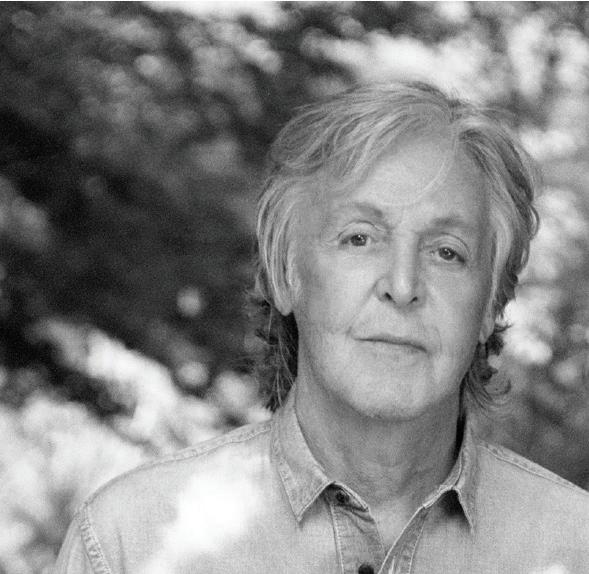
Walking the crowd through his career, McCartney spoke about first meeting John Lennon in Liverpool when they were both young songwriters. McCartney told the attendees that “he wasn’t too keen on John” because when they first met, “John had been drinking beer” and critiqued McCartney’s piano skills. McCartney went on to reminisce about his and Lennon’s family backgrounds.
“I’d been brought up in a very loving family with my dad,” McCartney said. “Lennon’s family had not been like that with a lot of horrible things happening to him growing up. This made him


acerbic, witty and sharp which I loved and made our songwriting so powerful.” Because McCartney is lefthanded, and Lennon was righthanded, McCartney said the two mirrored each other when composing together. Even though Lennon was killed more than four decades ago, McCartney told attendees that he still thinks about Lennon when he writes songs. When Hammer asked about where McCartney’s love for writing came from, McCartney told attendees about his experience with an English teacher who exposed him to Charles Dickens and other literary giants.
McCartney started in the English literature class at 16 as an “uninterested student,” but he said he quickly fell in love with Geoffrey Chaucer and William Shakespeare as his teacher “brought the words to life” through explaining the meaning of archaic phrases the writers used.
“The crazy early words these authors had written were fascinating, and he made it relatable,” McCartney said. “I’m very grateful from the bottom of my heart about the education I’ve received, and I ended up doing quite well in that one subject.”
Beyond his lyrics and songwriting history, McCartney also shared some of his favorite memories from performing with the Beatles, including a time the
Beatles refused to play for a segregated audience in Jacksonville, Florida. McCartney told attendees that the group’s protest forced the venue to integrate the crowd.
He also explained that he was inspired to write the “Sgt. Pepper’s Lonely Hearts Club Band” record after he misheard someone say “salt and pepper.” McCartney then discussed the inspiration behind the hit songs “Hey Jude” and “Yesterday.”
Though he did not sing for the audience, McCartney told attendees that if he could have written any song by another artist, he would have wanted it to be “God Only Knows” by Brian Wilson of the Beach Boys.
For attendees, the event was “a once in a lifetime opportunity” to see someone whose work has impacted generations of people. Many Yale affiliates brought their parents who had first shared McCartney’s music with them to the event.
“I grew up on his music, and it virtually changed my life,” Thomas Violante, an attendee and former University spokesperson, told the News. “I started a rock band right after I heard ‘She Loves You’ and ‘I Want to Hold Your Hand.’ … Absolutely a living legend.” The public ticket sale for the event launched on Feb. 11 at 2 p.m. and sold out within minutes.
Attendees — and hopeful attendees — lined up to get seats within Woolsey Hall starting at noon.
Tickets were originally supposed to launch on Feb. 8. However, YaleConnect, the system through which tickets were originally sold, crashed within 10 minutes of the ticket release after thousands logged on to claim their free ticket.
“We’ve seen him a dozen times in concert, so when we heard about this, we thought, ‘This is new, this is di er-
ent, this is not something we’ve ever seen him do before’ — to sit down in front of us and tell stories,” attendee Gabe Serrano told the News. “It was really cool to hear him talk about family life, Liverpool, and his love of English language and literature.” Woolsey Hall has a capacity of 2,650.
Contact YASH ROY at yash.roy@yale.edu and EVAN GORELICK at evan.gorelick@yale.edu .
Students rally for religious housing accomodations

HOUSING RALLY FROM PAGE 1
Speakers recounted the challenges obtaining religious housing accommodations, which they said posed a unique burden to Muslim women even under the old housing system. Kadidia Sylla ’24 told the crowd about the “inconveniences” she faces as a hijabi who has shared a bathroom with men for the past two years.
In all-gender bathrooms, Muslim women are prevented from practicing wudu, a cleansing ritual that is performed before worshiping. Wudu must be done without wearing the hijab, which can leave Muslim women in an all-gender bathroom “paranoid,” according to Sylla.
“I hope that no one else has to deal with these issues that I have had to deal with,” Sylla said. “I haven’t even been able to ask for religious accommodations because I don’t feel comfortable doing so knowing that it’s not something that Yale prioritizes.”
All-gender bathrooms also present challenges for those practicing Orthodox Judaism, which emphasizes modesty.
Eytan Israel ’26 spoke to the crowd on the steps of Sterling Memorial Library, recounting his experience requesting an all-male bathroom for religious purposes.
The new housing system also does not formally include accom-
modation requests for Shabbat-observant Jews, which prohibits using electronic devices of any kind like motion-sensored sinks or toilets and key swipe access into Yale buildings.
“I want to be part of the residential college community,” Israel told the crowd. “That’s why we’re working. We’re trying to work with the system to make it more accessible to all.”
The organizers of the protest, originating from a multitude of student organizations, emphasized that the rally was an “interfaith effort.”
“The main point of today’s protest was to emphasize that there is a great deal of support for this initiative while also acknowledging that there are ways to work with the administration to bring this to reality,”
MSA Student President Zahra Yarali ’24 told the News.
Yarali told the News that she and other student organizers will be meeting with the Yale College Dean’s office in the near future to hopefully come to an agreement.
The Yale housing room selection will begin on April 10.
Contact KAITLYN POHLY at kaitlyn.pohly@yale.edu and TRISTAN HERNANDEZ at tristan.hernandez@yale.edu .
YALE DAILY NEWS FRIDAY, FEBRUARY 24, 2023 yaledailynews.com · @yaledailynews PAGE 5
CONDOLEEZZA
"You never cede control of your own ability to be successful to something called racism."
RICE FORMER U.S. SECRETARY OF STATE
YCBA FROM PAGE 1
MCCARTNEY FROM PAGE 1
The organizers of the protest, originating from a multitude of student organizations, emphasized that the rally was an “interfaith e ort.” / Kaitlyn Pohlly, Contributing Photographer
For attendees, the event was "a once in a lifetime opportunity" to see someone whose work has impacted generations of people. / Courtesy of Mary McCartney
Content Warning: an article on this page refers to suicide
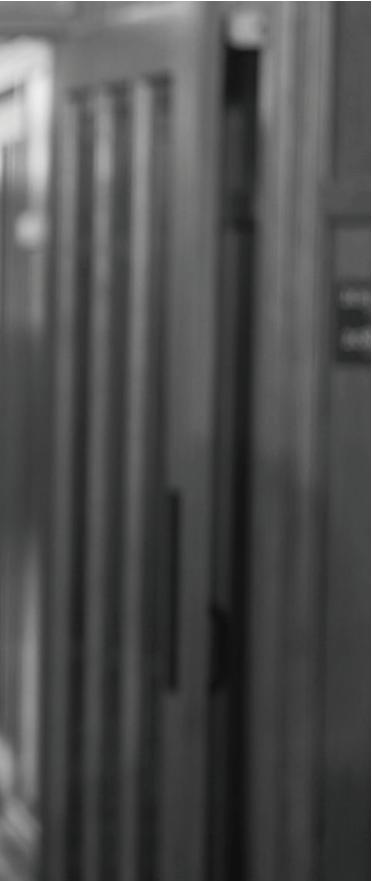
Cajetan Iheka named director of Whitney Humanities Center
MIRANDA
WOLLEN STAFF REPORTER
Cajetan Iheka has been triply appointed as director of the Whitney Humanities Center, the fi rst African-born chair of the Council on African Studies and the head of the Yale Africa Initiative.
The latter two positions are through the MacMillan Center for International and Area Studies, a teaching and research center focused primarily on foreign cultures and nations. Iheka will officially step into the roles on July 1.
“I look forward to bringing a more global vision of the humanities to the work of the Whitney through programming and its visitors,” Iheka said.
Iheka had previously been a member of the Council of African Studies, which aims to “seek novel approaches to issues” in
the field through joint ventures with a number of Yale organizations, per its website.
The Yale Africa Initiative focuses on promoting African scholarship, discourse and research, as well as strengthening present-day relationships between Yale and African institutions and bringing African scholars to the University. Iheka hopes to be able to build collaborative relationships between these institutions and the Whitney Humanities Center.
Prior to his appointments, Iheka worked as a professor in Yale’s English department, specializing in African literature, ecocriticism and ecomedia and postcolonial literature. He told the News that he would continue teaching and researching, roles he considers “inextricable” from his new position.
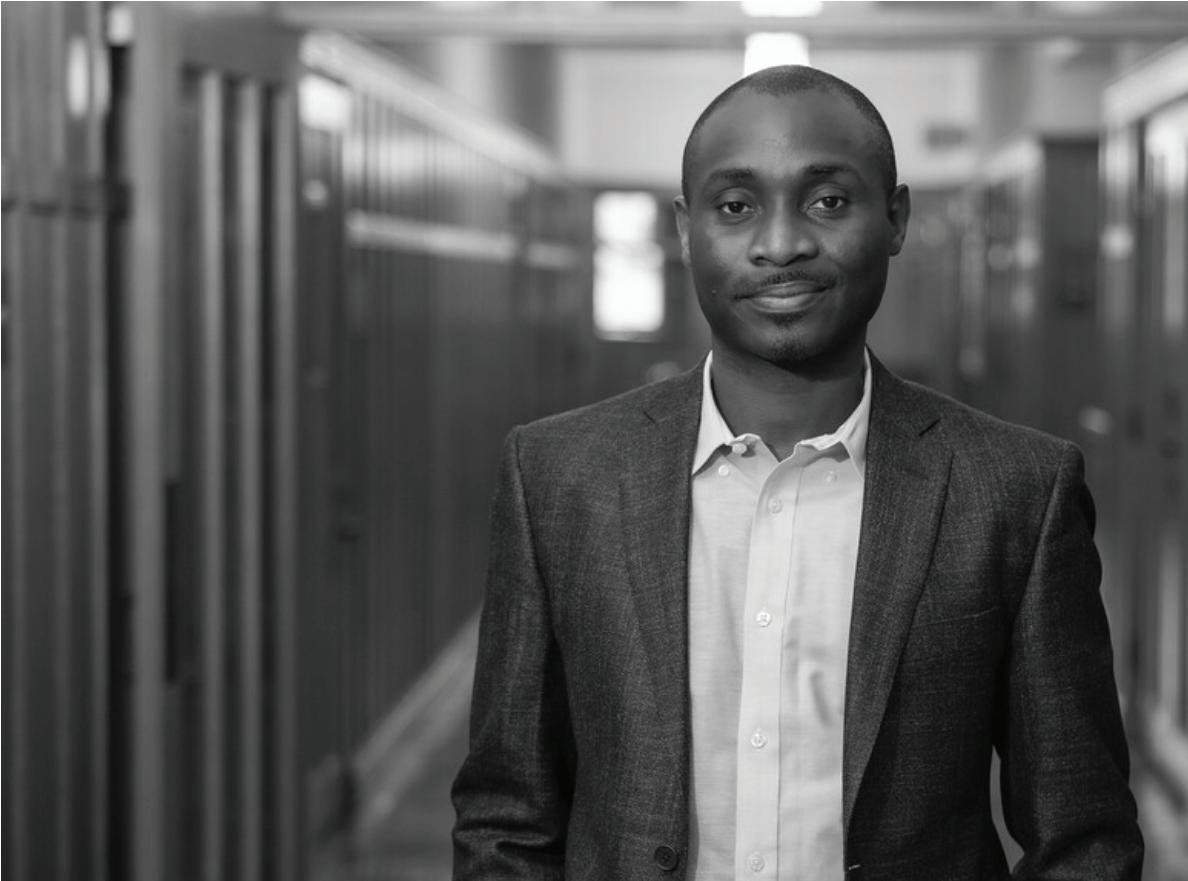
“His work is a landmark effort to consider how narrative participates in human beings’ rela-
tionship to climate change,” wrote Kathryn Lofton, acting dean of the FAS and dean of Humanities, in a statement on Feb. 13. At the Whitney Center, Iheka will stand at the helm of a variety of interdisciplinary projects dedicated to the humanities, including lectures, fellowships, conferences and research.
This fall, the Whitney Center will bring in its third cohort of fellows — a group of teachers and faculty from around the University who meet weekly to collaborate and converse about their works-in-progress.
“Cajetan’s intellectual reach and enthusiasm for working with scholars from various disciplines and at all stages of their careers will bolster the WHC’s role as a hub for innovative research and interdisciplinary collaboration connecting scholars in the
humanities at Yale and beyond,” Whitney Center associate communications officer Megan O’Donnell wrote to the News.
O’Donnell noted specifically that she hoped to see the Whitney Center’s new Environmental Humanities Fellowship grow under Iheka’s care.
Iheka is the editor-in-chief of the African Studies Review and the author of a number of books on postcolonialism and ecopolitics. Most of his work has been interdisciplinary by discipline, a trait Lofton explained she was excited to see him bring to the Whitney Center.
“Colleagues of Professor Iheka, a current Whitney Fellow, are inspired by his sense of the collective good that drives much of his work,” Lofton wrote. “His intellectual reach and enthusiasm for collaboration will build bridges from the
Whitney Humanities Center at the Humanities Quadrangle to scholars across the University.”
Steven Wilkinson, chair of the MacMillan Center, expressed similar eagerness regarding Iheka’s boundary-breaking work.
Wilkinson cited the Black Environmentalisms Symposium that Iheka co-organized last October and said that he is “excited for the creative vision and intellectual rigor that he brings to these roles.”
Iheka’s term will last three years, as did that of his predecessor Alice Kaplan, Sterling Professor of French and founding director of the Yale Translation Initiative.
The Whitney Humanities Center is located at the Humanities Quadrangle.
Contact MIRANDA WOLLEN at miranda.wollen@yale.edu .
Remembering Garrett Woodard ’23
BY ANIKA SETH, MIRANDA WOLLEN & SARAH COOK STAFF REPORTERS
Content warning: This article contains references to suicide.
The National Suicide Prevention Lifeline is a hotline for individuals in crisis or for those looking to help someone else. To speak with a certified listener, call 1-800-273-8255.
Crisis Text Line is a texting service for emotional crisis support. To speak with a trained listener, text HELLO to 741741. It is free, available 24/7 and confidential.
To talk with a counselor from Yale Mental Health and Counseling, schedule a session here. On-call counselors are available at any time: call (203) 432-0290. Appointments with Yale College Community Care can be scheduled here.
Students who are interested in taking a medical leave of absence should reach out to their residential college dean.
Additional resources are available in a guide compiled by the Yale College Council here.
Garrett Woodard ’23, a senior in Berkeley College, died by suicide last week at the age of 23.
An architecture major from Selma, North Carolina, Woodard is remembered by his loved ones as a dedicated artist and innovative thinker who cared deeply about his family and friends. Twenty-two of Woodard’s peers and family members shared memories of him with the News.
“I want to share Garrett’s childlike sense of wonder and his never-ending desire to learn
and grow and see the world,” sister Marilee Woodard told the News. “The way he treated people, always making people happy, and never hurting a living thing are what he strived for every day.”
Ernestina Hsieh ’24, a fellow architecture major, enrolled with Woodard in the fall of 2018. During their sophomore year, they collaborated on a community housing project. Woodard’s work, Hsieh said, was characterized by clean lines and keen attention to detail.
In a joint statement to the News, members of Woodard’s architecture studio wrote that he would often lean over to closely look at their projects, examining them from every angle. Whether looking at a sketch or a fully-developed piece, Woodard was always quick to offer his peers praise.
“When he was done, he would turn to you slowly, eyes wide open, huge smile on his face, and say, ‘Dude!’” the students wrote. “It was a look that said, ‘Do you realize what you’ve done?’”
Like Marilee Woodard, Hsieh described Woodard as intensely creative — not only through architecture, but also through music. Ben Lauring ’23, who met Woodard as a sophomore, said the two immediately started collaborating on “jam sessions” around campus. Lauring said Woodard was “obsessed with music,” a trait that was evident to anyone who saw his thousands of liked songs on Spotify.
Another one of Woodard’s friends, Giacomo Glotzer ’23, was Woodard’s roommate during their sophomore year. Glotzer
said their shared room was like an art gallery, as Woodard tended to display others’ art over his own. He arranged pieces in creative ways, with posters pasted on the corner between the wall and the ceiling.
Glotzer and Woodard spent time together in New Haven last summer, when Woodard was working at Luckey Climbers, a company that designs playgrounds. Glotzer remembered spending his birthday with Woodard, when they sat outside and recounted stories from their past few years of friendship.
Glotzer also recalled Woodard’s love for exploring and spending time outside. Woodard spent the summer after his first year in Bhutan and spent part of his gap year working with the ACE Conservation Corps. He was an avid skier, known to whiz past friends on black diamond slopes and then meet them at the bottom with a grin.
Lauring recalled a hike he had gone on with Woodard last March, when they came upon a group of three fellow hikers who spoke only Spanish. Woodard, who Lauring said spoke the language at an “L2 or L3” level, tried to make conversation with them. After a valiant effort, Woodard insisted on getting a selfie with the hikers before they parted.
“When you’re with Garrett he really makes you feel… like a kid a little bit, in the best way,” Lauring told the News. “He’s curious about everything and about everybody.”
Woodard’s friends spoke fondly about his quirks: he lit incense and sent friends albums when they had a hard day. He
befriended strangers and sang in his room. For long stretches of time, he would go vegetarian out of concern for the environment.
Housemates Lauring, Lucy Minden ’23 and Ignacio Diaz Pascual ’23 all described Woodard as a relentless optimist — someone who saw the best in people and never held a grudge.
Glotzer also recalled Woodard’s love for his family. He said Woodard’s mom would often send massive quantities of baked goods to their house which he would share with all of their housemates.
“Garrett loved his parents and his sister so much,” Glotzer said. “One of my favorite quotes that he would always say is, ‘I just fucking love my mom, man.’”
Marilee Woodard attributed her brother’s “sense of wonder of the world and curiosity” to their father, who she said instilled and helped cultivate these traits in his son. Woodard was an Eagle Scout, and he and his father spent time together hiking, camping and backpacking. The entire family “valued the beauty and complexity of the natural world,” according to Marilee Woodard, and shared a love of the outdoors.
Marilee Woodard told the News that after her brother’s passing, Berkeley students gathered and wrote letters to his family — “they’re all amazing,” she wrote to the News. She added that her brother’s family and friends intend to “carry his memory throughout the rest of [their] lives” by advocating for more mental health awareness and resources for those who are struggling.
Woodard’s fellow architecture studio members wrote that
among the qualities in Woodard that they will most miss are “his cheeky smile, his crossed legs, his skateboard walk, and his stripes.”
“[His smile was] one of the first things I noticed about him,” Diaz Pascual told the News. “When he smiled it was with his whole entire being. Every part of his face lit up.”
He is survived by his sister, Marilee Elisabeth Woodard, and parents, Gary Paul Woodard and Susan Watson Woodard.
The National Suicide Prevention Lifeline is a hotline for individuals in crisis or for those looking to help someone else. To speak with a certified listener, call 1-800-273-8255.
Crisis Text Line is a texting service for emotional crisis support. To speak with a trained listener, text HELLO to 741741. It is free, available 24/7 and confidential.
To talk with a counselor from Yale Mental Health and Counseling, schedule a session here. On-call counselors are available at any time: call (203) 432-0290. Appointments with Yale College Community Care can be scheduled here.
Students who are interested in taking a medical leave of absence should reach out to their residential college dean.
Additional resources are available in a guide compiled by the Yale College Council here.
Contact ANIKA SETH at anika.seth@yale.edu, MIRANDA WOLLEN at miranda.wollen@yale. edu, and SARAH COOK at sarah. cook@yale.edu .
PAGE 6 YALE DAILY NEWS FRIDAY, FEBRUARY 24, 2023 yaledailynews.com NEWS
YALE NEWS
“Love is metaphysical gravity.” R. BUCKMINSTER FULLER AMERICAN ARCHITECT
The English professor will take on the directorship next year alongside two other leading positions at the MacMillan Center.
Mayoral candidate protests as alders confirm BOE nomination
Elicker told the News that he believes the BOE has made progress on improving test scores and absenteeism, highlighting recent funding towards after-school programs.
He added that “it was unfair” to “denigrate” NHPS teachers and administrators for the work they do.
“I think it’s really interesting that Tom’s talking about education,” Elicker said. “I’ve been on the Board of Education for three years and I have not seen him at one meeting.”
During Tuesday’s Board of Alders meeting, Fair Haven’s Sarah Miller was the only alder who spoke in opposition to Wilcox’s nomination, citing concerns about the fact that not a single member of the BOE except the mayor has a child attending New Haven schools. She added that she was concerned by Wilcox’s lack of engagement with parents and broader community concerns, as well as his deference to the superintendent on a staffing issue where 53 teachers were allegedly transferred for “speaking out against the school system.”
Mayoral candidate Tom Goldenberg’s opposition to the renomination of Matt Wilcox to the Board of Education fell flat at Tuesday’s Board of Alders meeting.
The BOA confirmed current BOE vice president Wilcox, whose term expires in 2023, by a voice vote at Tuesday’s meeting. Goldenberg has called on the BOA to halt all nominations to the BOE until the BOE agrees to meet in person and presents “tangible plans” to improve test scores and attendance in the city. Moreover, Goldenberg has called on the New Haven Public Schools district to include parents and students in the ongoing superintendent search process.
Before the meeting, Goldenberg hosted a rally outside of City Hall where he expanded on his education plan for the city, which New Haven Mayor Justin Elicker has called a “political charade.”

“We need to hold our elected officials accountable and remind them who puts them in office,” Goldenberg said at his rally. “That’s why I’m calling on the Board of Alders to not reappoint any Board of Education members until these demands are met. That’s why I’m calling on the Mayor to do his job. In-person meetings, now. Teachers and parents on the search committee, now. We cannot wait.”
Goldenberg said that during his time as a consultant for McKinsey he met with superintendents across Connecticut who frequently reflected on the “dysfunction” of New Haven’s Board of Education.
For him, the buck stops with the Mayor, who he alleges has failed to address the problems facing the district.
“The Mayor is failing us on education,” Goldenberg wrote to the News. “It is not the governance structure to blame — it is the lack of governing and leadership.”
Goldenberg told the News that he felt compelled to speak out after the release of reading test scores where 84 percent of third graders were reported as not reading at the recommended level.
He added that presentations from NHPS arguing that “everything is fine” and “this is because of COVID,” instead of more serious reflection on what changes should take place, had “made him mad.”
“What does that mean for the 19,000 students in NHPS, and their futures,” Goldenberg said. “As a parent of an NHPS student in kindergarten, and as someone who is proud of New Haven, this was concerning. But what happened next changed my concern into anger.”
At Tuesday’s protest, Bethel A.M.E Church Pastor Steven Cousin Jr. also spoke out against the current trajectory of NHPS.
Cousin saud that the BOE must commit to in-person meetings so that community members can meaningfully contribute to the governance of the school.
“We seem to be living under this moniker that good enough is good enough, being good enough is the enemy of being great,” Cousin said. “I’m calling on the Board of Alders to take a really serious look at who we appoint because this is not just about students today but also students in the future.”
Goldenberg also spoke out against the ongoing superintendent search process, which he says does not include “meaningful input” from parents and students. The current search process has involved community conversations with parents and students about the new superintendent; however, Goldenberg and other activists have argued that parents and students should be included in the committee that ultimately chooses the superintendent. Goldenberg added that he has asked the district and mayor to open the process multiple times without response.
“We don’t know who will be appointed superintendent and what new dynamic that may bring,” Miller said. “But Mr. Wilcox, his record is clear. And I believe of the 19,000 plus students in the new home school, surely one of their parents, guardians or caregivers would be a better fit for this role.”
Alders Adam Marchand, Anna Festa and Eli Sabin ’22 all spoke in favor of the nomination. Each said that Wilcox had distinguished himself as a leader who was committed to developing NHPS.
“Mr. Wilcox is hardworking and diligent,” Sabin said. “He does his job. He’s responsive. And I think at the end of the day, being a Board of Education is a bit of a thankless job. So I don’t think we should take that for granted that we have someone who wants to work hard and is making decisions in the best interest of our city.”
However, Sabin added that he “did not want his vote to be a message” that the current trajectory of the board was acceptable.
There are 30 members of the New Haven Board of Alders.
Contact YASH ROY at yash.roy@yale.edu .
Yale security officers ratify historic five-year labor contract
HANNAH KOTLER AND MEGAN VAZ STAFF REPORTERS
Following eight months of negotiating, the labor union representing Yale Security officers voted overwhelmingly to ratify a new five-year contract with the University on Friday.
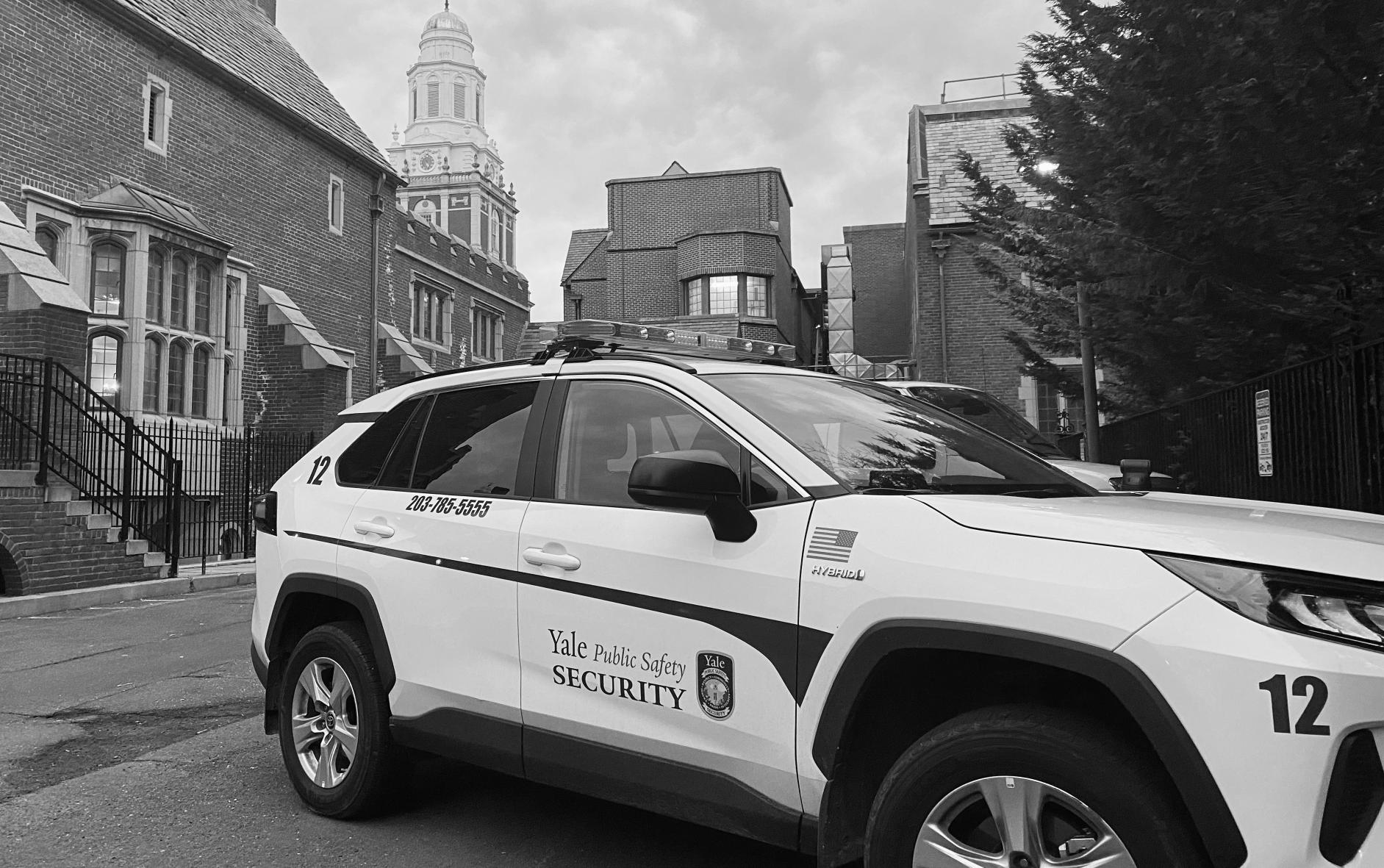
Members of the Yale University Security Officers Association streamed into a conference room at 25 Science Park on Friday to cast their ballots for the contract. The University and the union had reached the five-year agreement on Feb. 7, University spokesperson Karen Peart told the News. According to Peart, compensation was the central theme of the negotiations.
The labor agreement includes employees’ first ever 10-year pay scale, wage raises across the board and new due process rights for officers being investigated under complaints. Union leaders at the ratification vote described the contract as “historic.”
“I didn’t think they were gonna go this high,” said YUSOA President Bob Corso. “But I think they realized that we were underpaid for years. And they made it right. They started taking care of us the way we should have been taken care of.”
Yale Security officers, who YUSOA general counsel Andrew Matthews and Corso described as the lowest-paid workers in the University, will now receive starting wages of $21.75 per hour, an increase from the previous hourly wage of $18.50. Workers’ wages will rise on a nine-step yearly scale after the first year of employment.
According to Matthews, negotiations began in June, proceeding with mutual respect between the University and union. He emphasized the importance of the University recognizing that “people need to be able to take care of their families” during the negotiation process.
Peart, who has told the News in the past that the University takes an “interest-based”
approach to bargaining, agreed that the contract “would include significant improvements to staff compensation.”
In addition to increased wages, the contract includes sweeping changes to the investigative process for complaints regarding officers. According to Matthews, investigative bodies must now give an officer a copy of any complaint made against them. The contract also explicitly states that these officers have the right to union repre -
sentation throughout investigations, although such representation is already required by law.
Corso added that having a recognized union for the past 12 years has forced the University to respect Yale Security officers. Corso, who has worked with Yale Security since 1999, discussed the lack of dignity workers received before the YUSOA was organized in 2011.
“We’re always considered like the red-headed stepchild of the University,” Corso said. “We just didn’t get paid.”
YUSOA is one of five unions with contracts at Yale. Like the Yale Police Benevolent Association, the union is independent of any parent organization. Corso told the News that he felt the other unions were behind them “100 percent” throughout the negotiation process.
Matthews, who also represents YPBA, said that the union looks to push the University toward improving the multiplier for pension calculations, which could make retirement more affordable for many workers.
“We’re going to spend the next five years getting ready to do the next one, because we really believe that people have to be able to afford to live on their pension to survive,” Matthews said. “We live in Connecticut, one of the most expensive states in the country.”
YUSOA’s previous contract was ratified in May 2019 and expired on Jan. 20, 2023.
Contact HANNAH KOTLER at hannah.kotler@yale.edu and MEGAN VAZ at megan.vaz@yale.edu .
YASH ROY STAFF REPORTER
PAGE 7 YALE DAILY NEWS FRIDAY, FEBRUARY 24, 2023 yaledailynews.com NEWS
SOPHIE SONNENFELD/CONTRIBUTING PHOTOGRAPHER
After months of negotiations, the University and the Yale Security officers’ union reached a five-year agreement including wage raises and expanded due process rights.
YASH ROY/CONTRIBUTING PHOTOGRAPHER
Tom Goldenberg has called on the Board of Alders to vote down all BOE nominations until NHPS makes clear commitments to transparency, accountability and rigor.
“You may not control all the events that happen to you, but you can decide not to be reduced by them.”
MAYA ANGELOU AMERICAN POET
AND TECHNOLOGY
YSPH research reveals relocation and reeducation of Ukrainian children
BY GIRI VISWANATHAN STAFF REPORTER
A new report from the Yale School of Public Health has uncovered a systematic Russian program to re-educate and relocate Ukrainian children, which researchers allege is a violation of international law.
The report — published on Feb. 14 by YSPH’s Humanitarian Research Lab as part of the State Department-funded Conflict Observatory program — documented the relocation of over 6,000 children from Ukraine via a network of 43 re-education and adoption facilities stretching from Crimea to Siberia.
According to the report, the majority of camps engage in pro-Russia re-education initiatives, while others have given children military training and prevented their return to their parents — violating international human rights law.
“We were able to clearly identify immediately that the activities that Russia’s officials were describing were violations of the Fourth Geneva Convention,” said Nathaniel Raymond, executive director of the HRL. “In some cases, there were also alleged crimes against humanity in violation of the 1998 Rome Statute, on prohibitions of transfer of children from one group to another for the purposes of erasing national identity.”
According to Raymond, the research team had been “watching” the relocation program since early Spring 2022 — shortly after Russia’s invasion of Ukraine — and was a “clear priority” for the U.S. government. By October or November, the HRL researchers had developed the methodology and data sources to begin documenting the transfer of Ukrainian children.
To do so, Raymond noted that HRL used open-source information to develop their understanding of the network of relocations, camps, re-education efforts and adoption and foster placements.

HRL identified facilities through social media posts, government announcements and news reports. They also obtained public telegram messages from Russian officials and from Ukrainian parents who
shared potential information about the children’s whereabouts.
The research team then verified these locations using high resolution satellite imagery of suspected camp locations, according to Raymond. A combination of the satellite imagery, reference photographs and videos on camp websites, along with user-generated photos on mapping sites like Yandex Maps, were employed to geolocate camp facilities. Each location was independently confirmed by at least two researchers before being included in the report.
To accomplish the task of large open-source research, the HRL worked with a research group across the University. Although, according to Raymond, the names of team members and group sizes could not be disclosed for security reasons, he emphasized that students and faculty from multiple parts of the University were involved.
“Yale students should know there are heroes among [them],” Raymond said. “You may not know who they are, but when you see this work, you should be proud of it. Because it’s your colleagues and fellow Yalies who are making it happen.”
The HRL was able to conduct open-source research because, rather than concealing the relocation networks’ existence, the Russian officials involved celebrated it. According to the report, the camps were marketed as either recreational or humanitarian: to provide kids with vacations or to save them from active warzones.
As a result, many officials “celebrate” their involvement in social media posts, interviews to media outlets or photographs with Ukrainian children at Russian-controlled facilities.
“They really believe that somehow Ukraine should not exist, that Russia has the right to rule the territory that is Ukraine and that the people in that territory should be Russian,” said David Simon, director of the Genocide Studies Program who was not involved in the study. “The reason why I think that they’re so unabashed in saying what they’re doing is that … they don’t believe in Ukraine.”
The report’s findings, however, paint an even more grim picture.
Since the Russian invasion of
Ukraine on Feb. 24, 2022, more than 6,000 Ukrainian children have been held in Russia’s custody across at least 43 facilities, including a psychiatric hospital and a family center. The network stretches from Russian-occupied Crimea to Siberia: a camp in Magadan — 3900 miles away from Ukraine’s border — is closer to the United States than Ukraine.
The true number of children and camps, Raymond added, is likely “significantly higher.” According to the report, 78 percent of camps were engaged in “systematic re-education efforts” that exposed Ukrainian children to pro-Russia academic, cultural and in some instances, military-style training. Multiple camps are advertised as “integration programs” to assimilate Ukrainian children into the Russian government’s “vision of national culture, history, and society.”
At least two camps hosted orphaned children and placed them with Russian foster families. More than 20 of those Ukrainian children were placed with families in Moscow and enrolled in local schools.
According to the report, the network is centrally operated by Russia’s federal government, including local, regional, and federal leaders at every level of government. At least 12 of the individuals involved in the program are not currently on United States or international sanctions lists.
“It’s tragic to say this, but on virtually every front, whatever the official Russian press release is, the one thing you can count on is that the opposite is true,” said Jeffrey Sonnenfeld, SOM assistant dean. His research team has investigated the exodus of companies from Russia after its invasion of Ukraine.
In many instances, the report continued, consent from Ukrainian childrens’ parents were obtained under duress. The report details how parents were made to sign over power of attorney, how agreedupon terms of stay lengths were violated and parents’ refusal to allow their children to attend camps “were ignored” by organizers.
In at least four camps — including Medvezhonok which hosts at least 300 Ukrainian youth — childrens’ returns to their parents were suspended, and they are being held
past their scheduled date of return. Parents also report being unable to obtain information about their children’s whereabouts after their return is delayed.
“It’s worse than misinformation: it’s disinformation,” Sonnenfeld said. “It’s intentional deceit, and that’s what we have here. And this is just one more piece of evidence to say that [Putin is] … targeting civilian populations.”
According to Raymond, the systematic relocation, re-education and resettlement of Ukrainian children is “absolutely” a prima facie violation of human rights and the laws of war. He underscored that point, especially, since he believes that the “number of locations and children is significantly higher”— a theory he intends to prove.
The report emphasized that the program’s adoption, unnecessary transfer, political indoctrination, military training and prolonged custody without parental consent of Ukrainian minors may constitute potential violations of the Convention on the Rights of the Child and the Geneva Conventions.
Simon also pointed out Article 2(e) of the United Nations Convention on the Prevention of the Crime of Genocide, which includes “forcibly transferring children” of one group to another as one of the crimes that constitute genocide.
“Russia even changed its adoption laws to make it easier to adopt Ukrainian kids and transfer those Ukrainian kids to Russia, so that they may be raised as Russian kids,” Simon told the News. “That’s what forcibly transferring children of a group to another group means. There are only five sets of acts that qualify under that convention, and it’s one of them.”
For some Ukranian students at Yale, the report was startling.
According to Sofiya Bidochko ’24, a Ukrainian-American student whose extended family lives in Ukraine, the report’s documentation of Russian mass-relocation and re-education initiatives makes her “sick to [her] stomach”
“I grew up learning about my great great grandfather being forcibly sent to his death to a labor camp in Siberia and I ques -
tioned how such an act was ever allowed to be permitted by the world,” Bidochko wrote to the News. “And now I learn of these poor children who are also sent to ‘reeducation’ camps … all of them being forced into an identity meant to erase them of being Ukrainian, and I cannot comprehend how this is not being stopped before our eyes.”
Moving forward, Raymond and the HRL hope to continue investigating humanitarian crises in Ukraine. While Raymond mentioned an additional investigation on another Ukraine-related crisis slated to be published next month, he emphasized how the report has had a “catalytic effect.”
On Wednesday, Feb. 22, Raymond and Kaveh Khoshnood, the faculty director of the HRL, will present their findings at a United Nations summit addressing atrocities committed by Russia in Ukraine. While Khoshnood understands that the report might not immediately cause a change in policy, he remains optimistic about the research that his team conducts.
“We do however know that such evidence-based reports do not always “translate” into appropriate policy and practice changes,” Khoshnood wrote to the News. “This is a challenge that public health academicians typically experience on many topics, but regardless of this challenge, we will do our best.”
Since the report’s release, it has been cited by Vice President Kamala Harris and Secretary of State Anthony Blinken in calls to investigate atrocities committed in Ukraine.
A State Department press release on the report declared the relocation network a “grave breach of the Fourth Geneva Convention” and called for Russia to “immediately halt” transfers and deportation, to return children to their families, to provide registration lists of the children and to grant access to outside independent observers to the network’s facilities.
The Conflict Observatory was announced by the State Department on May 17, 2022.
Contact GIRI VISWANATHAN at giri.viswanathan@yale.edu .
School of Environment models effects of climate change
BY HANWEN ZHANG STAFF REPORTER
Assistant professor of computer sciIf a tree falls in a forest with no around, it may still be modeled by the Yale School of the Environment.
A study co-authored by Yale researchers at the School of the Environment visualized global forest distributions to predict future changes in tropical biomass and the potential pace of climate change. While the model found that most tropical forests will likely remain intact, it forecasted a worrisome increase in atmospheric carbon emissions if improper forest management continues unchecked.
“We found that the effects of climate change on tropical biomass in general are not catastrophic, which is of course good news,” Maria Uribe, postdoctoral associate in the Paulo Brando lab, told the News. “However, there are important carbon losses that can increase drastically … if we don’t keep lowering our emissions.”
The findings are something of a mixed bag. While most forest spaces will not seem to lose significant biomass in the future, levels of resilience vary widely across the tropics. Michael Coe, co-author and senior scientist at the think tank Woodwell Climate Research Center, explained that the southeast swath of the Amazon rainforest was particularly vulnerable to biomass loss.
In a best-case scenario, the research found that forests could stand to capture up to 12 percent of aboveground carbon emissions. At worst, they could cause a 20.1 percent increase. Loss of biomass in the Amazon region would account for roughly 40 percent of all emissions.
“The project was an attempt to get an estimate of how much carbon could be lost only from
changes in climate in the tropics,”
Uribe wrote.
Uribe explained that such a model was not the first of its kind. Researchers have previously attempted to use vegetation to quantify carbon emissions, but most efforts had failed to capture the complexity of weather patterns or natural cycles and were riddled with uncertainties. While mathematically simpler, the team’s model better accounts for many of the earth systems such as drought and soil interactions.
The study was also novel in its expansive breadth. After modeling the forest space in northeast Brazil, the researchers at the Woodwell Climate Research Center realized they could map global forest density using just two factors—rainfall levels and dryness. This allowed them to create a temperature-sensitive model that directly linked aboveground biomass to changes in the climate.
Left unsolved, forest loss and rising temperatures have the potential to create a vicious feedback loop.
Large-scale forest fires can contribute to changes in climate, which in turn alter their biomass composition.
Climate change over the last 50 years led to forest losses that are equivalent to about 1.5 percent of the carbon reserves in 1950. Since warmer temperatures also slow the rate of photosynthesis, the world’s forests could be on track to lose 5.9 to 9.8 gigatons of carbon for every degree Celsius increase in temperature.
In the coming decades, shifts in climatic zones could lead to significant emission increases in the Americas and Asia even as parts of Africa become carbon sinks.
“We’re creating a system that is going to be very stressful for forests the way they are now,” said Maria Macedo, co-author at the Woodwell Climate Research Center.
Uribe added that the threats of “climate change, deforestation and
forest degradation,” when compounded, could make the forests increasingly vulnerable.
The silver lining, though, is that there is still time to act. Macedo and Coe stressed that these models were “a big warning signal,” a reminder of the forests’ environmental significance, but also a helpful glimpse into the future that would hopefully inform policy decision-making. By making sense of the relationship between climate and forest disturbances, Macedo explained that the models would “[connect] these natural ecosystems to the climate problem.”
“I think the most important… next step in this research is to… use it,” said Macedo. “I think it’s a
powerful way for people to visualize the changes that are coming.”
In the meantime, Coe suggested that proper management would be crucial to preserving what forest space remains. Priority should be given to protecting the forests that still exist and stewarding public land. He observed that forest restoration efforts, while attractive, do not nearly contribute as much to large scale change as we would expect.
In particular, the researchers emphasized that fire containment practices will need to improve.
Given that the model does not account for anthropogenic factors such as deforestation or fires, the research paper admitted that total carbon emissions were likely underestimated. Dry climates have also
increased threats of wildfires in rainforests not usually at risk of burning, potentially threatening the survival of tree saplings. Macedo recognized that preventing fires would require resources, “new strategies” and a willingness to “[learn] from other parts of the world.”
“We’re on a trajectory for [fires] to be even ... worse,” Macedo said. “[The model] still gives us some room to really think about how… we manage fires in the landscapes… while we do something about the global climate change problem.”
The world’s tropical forests lost a combined 11.1 million hectares in 2022.
Contact HANWEN ZHANG at hanwen.zhang@yale.edu .
SCIENCE
PAGE 8 YALE DAILY NEWS FRIDAY, FEBRUARY 24, 2023 yaledailynews.com COURTESY OF YALE UNIVERSITY
Climate
cli-
A recent study by researchers at the School of the Environment and Woodwell
Research Center offers a glimpse into potential
mate scenarios and future forests.
“My soul has grown deep like the rivers.”
Students to open “Kiss of the Spider Woman” in Saybrook Underbrook
BY CAMILLE CHANG CONTRIBUTING REPORTER
Yale’s first all-Latinx cast and production team will debut their production of “The Kiss of the Spider Woman” on Feb. 23, marking the first North American and in-person showing of the play since the 1990s.
“The Kiss of the Spider Woman” is set in a prison during the “Guerra Sucia,” or “Dirty War” in Argentina, a time when the Argentine military dictatorship carried out a state terror campaign that imprisoned and killed thousands of civilians. The play was first written by Manuel Puig in novel form in 1976, just two years out from the start of the war. In 1983, he adapted the novel into a dramatic production. It features only two characters who are physically present on the stage — cellmates Molina and Valentín — along with two other off-stage voice actors.
“The two characters have very different world views — I’d like people to walk away from the show understanding both,” said producer and lead actor Jordi Bertrán Ramírez ’24. “This is a story about two people who are in constant conflict. But if we’ve done our jobs well, both people are equally easy to empathize with.”
Bertrán Ramírez plays the role of Molina, a spirited character
who is imprisoned for “corruption of a minor.” He noted that the two characters in the play act as interesting contrasts to each other, representing “two extremes of yearning for freedom,” with Valentín searching for political freedom and Molina searching for freedom of expression.
David DeRuiter ’24, acting opposite Bertrán Ramírez, plays Valentín,
a political prisoner jailed for his involvement with an anti-government revolutionary group.
“While in the beginning they’re at odds with each other, their proximity in the cell brings them together” DeRuiter said.
“Of course, they fall in love, but there is a journey to get there.”
Bertrán Ramírez added that the conflict between the two characters’
personalities and backgrounds is a major part of the play, but that ultimately, its message is one of empathy and understanding.
Joaquín Lara Midkiff ’24 marks his directorial debut with “Kiss of the Spider Woman,” crediting the creativity and energy of the cast and crew for making his job “really easy.”
Lara Midkiff said that the
show is necessary in the current moment, especially for its nuanced representation of Latin American experiences.

“When [Latin America] is in focus for a lot of people in the United States, it’s draped in poverty and dirtiness,” Lara Midkiff said. “It couldn’t be further from the way we view ourselves and the people that I grew up with, and most recently, make theater with.”
DeRuiter adds that the entirely Latinx cast and crew made as much of a difference in the rehearsal space as in the performances themselves. He emphasized the importance of a production where “everyone’s on the same page,” already familiar with the play’s context and underlying history.
Bertrán Ramírez also emphasized the important role that the unity of the cast and crew played in producing the play.
“I want people to know that Latinx-led theater at Yale is possible,” he said. “Working with so many talented people, many of whom are participating in theater for the first time, has been a joy.”
“Kiss of the Spider Woman” will be shown at the Saybrook Underbrook from Feb. 23 to 25. Tickets can be reserved here.
Contact CAMILLE CHANG at camillechang@yale.edu .
If Pretty Hurts Ugly Must be a Muhfucka takes on beauty standards in sold-out mainstage performances
PALOMA VIGIL AND ANIKA SETH STAFF REPORTERS
From Thursday to Saturday night, the Yale Repertory Theatre was filled with audience members taking in “If Pretty Hurts Ugly Must be a Muhfucka,” a reflection on beauty standards inspired by West African folklore.
“If Pretty Hurts Ugly Must be a Muhfucka,” the Dramat-selected Spring Mainstage production, had the audience follow along as characters Akim, Massassi, Kaya and Adama — played by Tyler Watts ’25, Kadyn Liburd ’25, Eula Doele ’26 and Zada Brown ’24 — battled both self-imposed and societal beauty standards, specifically those that exist for Black women. Scripted by playwright Tori Sampson, the play, which was co-directed by students Simi Fagbemi ’24 and Megan Ruoro ’24, brought a story based on a Nigerian folktale to one of Yale’s largest stages.
“I want people to consider the ways in which the beauty standard controls our lives and what that standard looks like for Black women specifically,” stage manager Maya Fonkeu ’25 told the News. “This play does a great job of addressing a serious topic with some humor, but I don’t want the jokes and puns to distract from the message behind it. The beauty standard can do some real harm in our society and I want people to reflect on the ways it affects different people in different capacities.”
Supporting Fonkeu as assistant stage manager was Lula Talenfeld ’25. In addition to the cast and directors, the show was choreographed by Katia George ’25, produced by Chidima Anekwe ’24 and featured music composed by musical director Vyann Eteme ’25 and assistant music director Darren Markwei ’25. The first of four shows was on Thursday, Feb. 16 at 8 p.m. The last show, which was on Saturday night, was fully sold out.
In the play, four women struggle with beauty standards in different ways that tie them all to each other. Massassi, Kaya and Adama all envy Akim for her beauty — but Akim concurrently struggles with persistent pressure from her parents to preserve that beauty. Massassi deals with objectification and despises Akim for the attention that a boy in town, Kasim, gives to her. Kaya struggles to be socially regarded as a full person, in spite of not fitting into the normative beauty standard. Lastly,
Adama tries to combat intense external expectations.
Massassi, Kaya and Adama attempt repeatedly to damage Akim’s beauty, ultimately leading to Akim and Adama nearly drowning in the River JuJu. When Adama and Akim emerge from a “transcendent experience,” Fonkeu explained, they have a new take on society. As the town’s Chief deliberates on an appropriate punishment for Kaya and Massassi following the attempted murder, Massassi also comes to understand that she cannot exist within society’s restrictive expectations.
“It’s important to note that there are no villains in this story; some may
be quick to assign such a role to Massassi, but she deals with her own struggles and expectations that make her a victim as well,” Fonkeu wrote. “The only ‘evil’ in this plot is the beauty standard.”
“If Pretty Hurts” concludes with Massassi waking up from a dream and coming to the realization that she has the power to determine her own selfworth beyond her physical beauty as dictated by external standards.
The play is based on “Of the Pretty Girl and the Seven Jealous Women,” which is a Nigerian folktale set in a “whimsical world,” Fagbemi said. Accordingly, the creative vision for the production was a priority.
“I think we really wanted to lean into the magical realism aspects of the story,” Ruoro said. “It very much felt like a storybook story, so we leaned into that in our set design.”
The team began rehearsing the show in September. Leading up to tech week, their rehearsals included accent work, monologue practice, blocking, dancing and singing.
Another core goal for the directors was to open up the theater space to people that might not necessarily consider themselves “theater people,” Ruoro and Fagbemi both told the News.
“I’m very proud of all the people who were involved in this pro-
duction [for whom] it was their first time doing theater, not just at Yale but in life, [and] of the environment we created,” Ruoro said. “I think we became very much a family.”
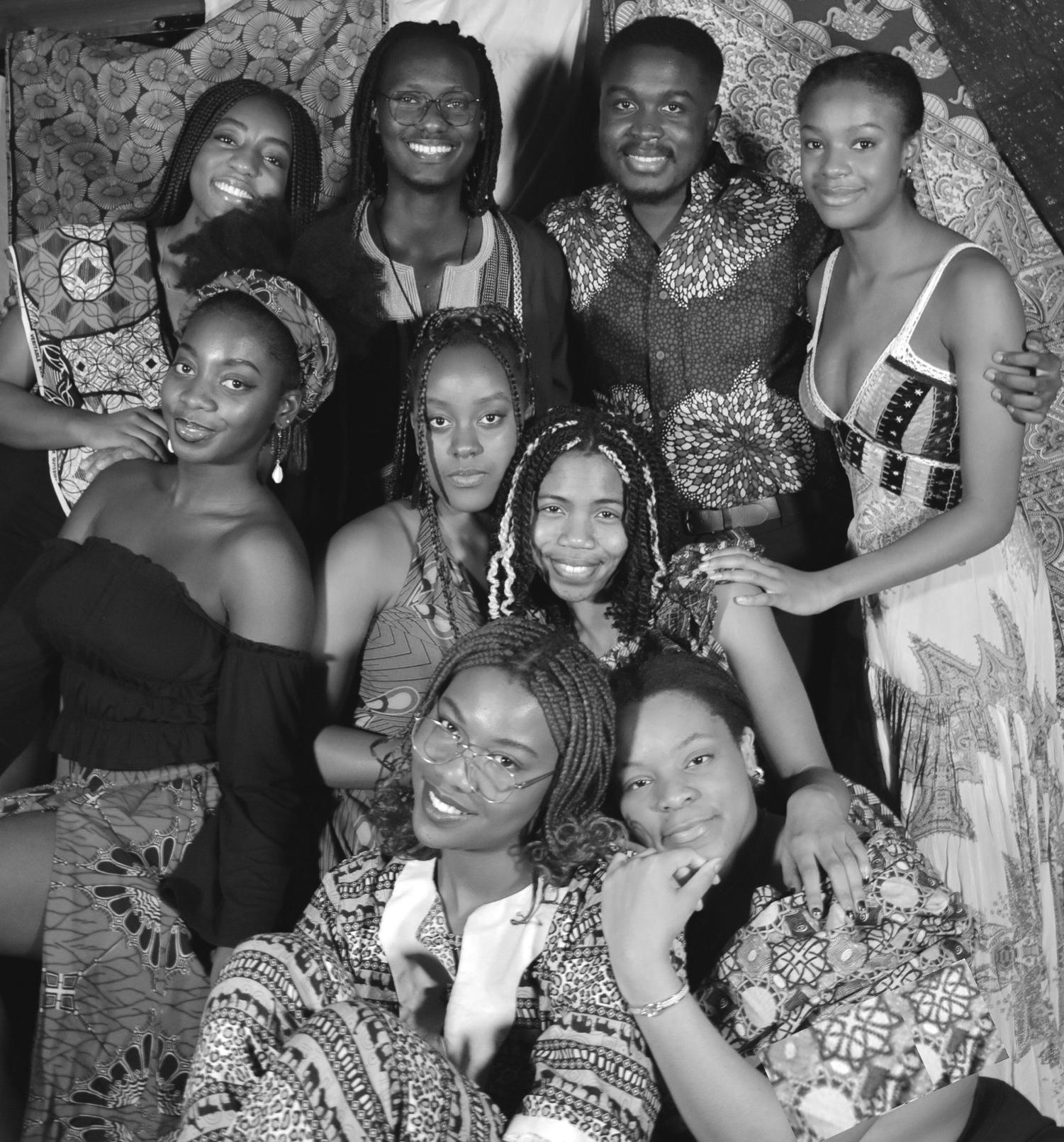
Participants spoke about their appreciation of the community that the cast and production team offered.
Brown told the News she had a “really great time performing” in “If Pretty Hurts” and noted her love for the inclusivity of participants of all experience levels.
“From the beginning of the process, everyone, regardless of whether they had tons of experience or were first time actors, was so kind and gracious to one another,” Brown wrote. “Performing on stage in front of an audience was just the most rewarding part of the whole process, it was so fun hearing their laughter, gasps, and applause, and I was really really happy that so many people felt so touched by our show.”
The production was Fagbemi and Ruoro’s directorial debuts. Fagbemi said she was inspired to put on “If Pretty Hurts” at Yale after she stumbled upon the script in a bookstore last summer and asked Ruoro if she wanted to produce it with her.
Fagbemi and Ruoro had previously acted together in Once On This Island, another predominantly-Black production that ran at the Lighten Theater from Apr. 16-18 2022. Other members of “If Pretty Hurts” were also involved in Once On This Island, a shared experience that Fagbemi said helped influence the development of “If Pretty Hurts.”
“It pretty much just takes one show to empower people to kind of do their own stuff, which I think is really fun and cool,” Fagbemi said.
Fagbemi told the News the show was like her “child” and she found the experience altogether empowering.
“My parents are Cameroonian so seeing West African culture represented on stage in such a unique manner was very exciting,” Fonkeu wrote. “And of course, being a Black woman working on a show that deals with Black beauty standards made me very invested and able to personally relate to the themes the show deals with.”
The first showing of Sampson’s play was on March 10, 2019.
Contact PALOMA VIGIL at paloma.vigil@yale.edu and ANIKA SETH at anika.seth@yale.edu .
ARTS PAGE 9 YALE DAILY NEWS FRIDAY, FEBRUARY 24, 2023 yaledailynews.com
CAMILLE CHANG/CONTRIBUTING PHOTOGRAPHER
The
play debuted on Feb. 23, marking the first, in-person North American showing since the 1990s.
COURTESY OF REGINA SUNG
The Spring Mainstage production, which ran from Feb. 16 to Feb. 18, was co-directed by Simi Fagbemi ’24 and Megan Ruoro ’24.
LANGSTON HUGHES AMERICAN POET
SPORTS
Women Hockey claims first-ever ECAC Regular Season Championship
The Yale women’s hockey team took the team’s first Ivy League Championship in program history.
BY SPENCER KING STAFF REPORTER
The No. 2 ranked Yale women’s hockey team (26–2–1, 19–2–1 ECAC) finished their regular season on a high note with victories over Dartmouth College and Harvard University that secured the Bulldogs their first-ever ECAC Regular Season Championship.
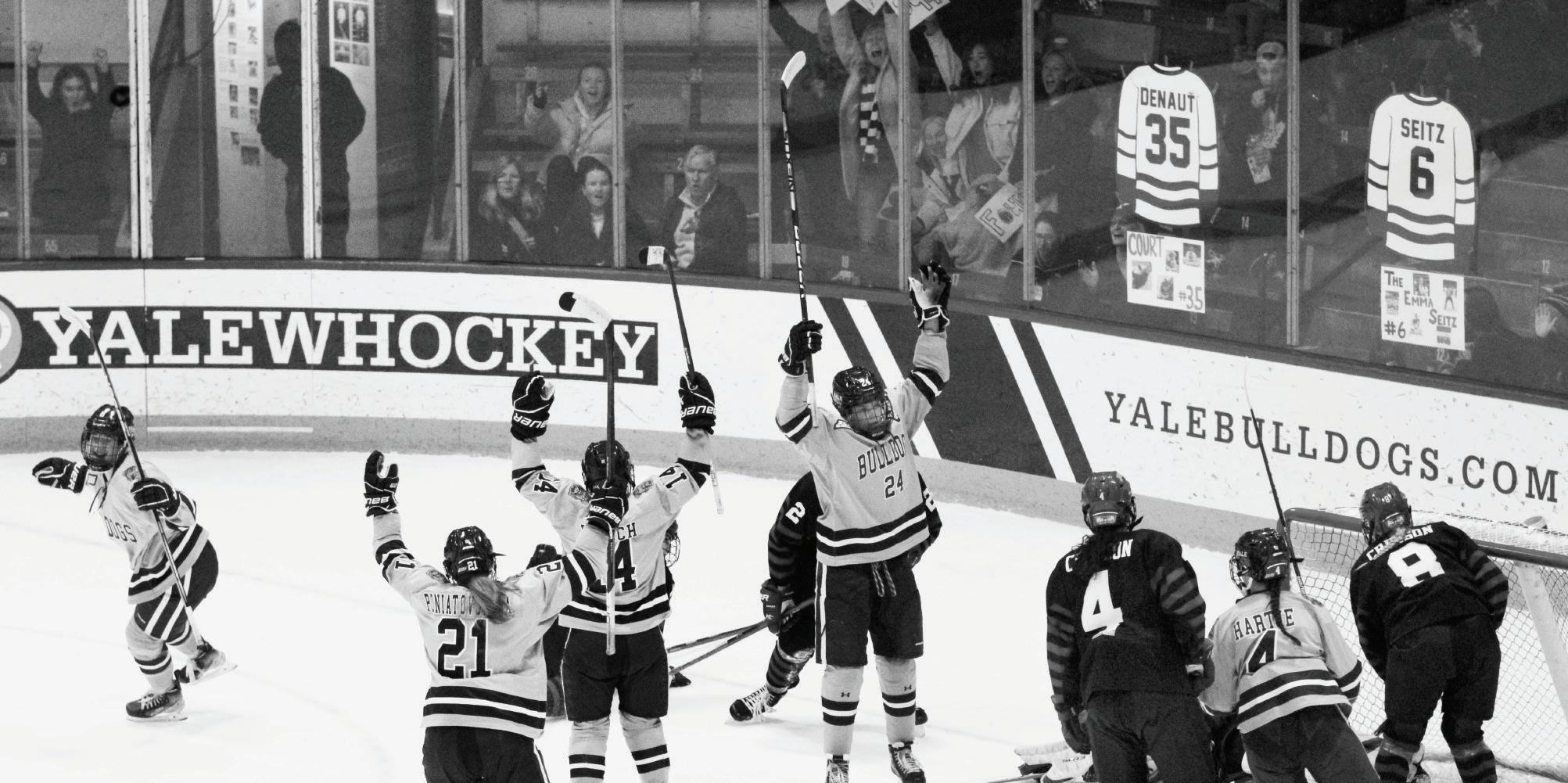
The win not only gives the Elis the regular season championship, but also grants them the top-seed in the ECAC Tournament, meaning they will have a home-ice advantage throughout the conference playoffs.
With a 6–1 victory over Dartmouth on Friday followed by a 10–1 shelling of the rival Crimson on Saturday, the Bulldogs secured
their second new program milestone of the last two weeks by winning the ECAC Regular Season Championship just one week after winning their first-ever Ivy League Championship.
“Great statement game for the team,” head coach Mark Bolding said. “We’ve obviously had a great year and lots of success, but it really helps to have momentum going into playoffs. Lots of different goalscorers and lots of authoritative, attackmode hockey, which was great. We know we defend well, so I think having some goalscoring confidence going into the playoffs is awesome.”
After defeating their rivals from Cambridge on Senior Night this Saturday in one of their best performances of the
season, the Bulldogs now get to host Harvard at Ingalls Rink in a best-of-three ECAC quarterfinals matchup next weekend.
Defenseman Sofie Zander ’23 scored her first career goal on Saturday against the Crimson.
“I’m pretty confident,” Zander said of the Bulldogs playoff chances. “We got a good thing going here so, I have no worries. We just play our game.”
Playing their game has gotten the Bulldogs to the point they are now, which stands as the best regular season in Yale history.
The Bulldogs 26 regular season wins are the most in team history, with the only blemishes being a tie to No. 14 Cornell and two losses at the hands of No. 3 Colgate. However, the team exudes confidence, with
the coaching staff and players believing they have built something special this season.
“We play every game like a playoff game, so hopefully not much will change,” captain Claire Dalton ’23 said. “I know that the girls are dialed in for that and it’s exciting that we’re gonna get to host and then hopefully host the next weekend.”
The matchup with a Harvard team they outshot 54–16 and put up double digit goals against should inspire confidence, especially in star forward Elle Hartje ’24.
Hartje posted a career day against the Crimson, which is notable for a player who last season set the Yale record for assists in a season and went second alltime for points in a season. Hartje notched her second-career hat
trick and earned an additional two assists to set a career best with a five point game.
For many, the shift in the program's fortunes has been sudden, but for seniors like Zander, the answer is clear.
“I definitely think the team dynamic, that [one has] changed a lot over the four years,” Zander said when asked about what was different within the team. “We’re a lot tighter right now, especially between classes which has helped a lot. We’re playing more as a team which I think is the biggest difference.”
Hartje enters the ECAC playoffs having recorded at least a point in the last 15 games.
Contact SPENCER KING at spencer.king@yale.edu .
No. 5 Bulldogs open season with win over Villanova
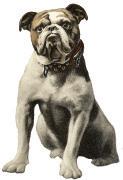 BY SPENCER KING STAFF REPORTER
BY SPENCER KING STAFF REPORTER
The fifth-ranked Yale men’s lacrosse team (1–0, 0–0 Ivy) began their 2023 season on a strong note with a 20–14 win over Villanova (1–1, 0–0 Big East) on Sunday. The story of the game for the Bulldogs was attackman Chris Lyons ’25, who posted a career day with a triple hat trick. His nine goals were the most by a sophomore in Yale history and were the second most all-time.
“It feels really awesome to get a win in our opening game of the season against a talented Villanova team,” goalie Jared Paquette ’24 said. “Our defense as a whole did a great job giving up saveable shots which made my job much easier.”
The game proved to be a shootout, with the Bulldogs reaching the 20-goal mark in their first game of the year, a feat they only accomplished three times last season.
The high-flying attack that peppered the Villanova goal with 51 shots was led by the same starting trio of attackmen the Bulldogs played last year, and the chemistry was evident.
Matt Brandau ’24 is the veteran presence up front. His fellow attackmen Lyons and Leo Johnson ’25 both played massive roles as rookies on the team last season, but have their sights set even higher this season and have put in the work to make it happen.
“[The fall preseason] gave Leo Johnson and Chris Lyons a real chance to grow up and be quar-

terbacks of the offense without me,” Brandau said to Inside Lacrosse of the fall season the two had together while he took a leave of absence. “A lot of guys had a lot of growing up this fall and hopefully that translates to maturity on the field.”

That maturity was evident on Sunday, with Lyons’ star ninegoal performance and Johnson adding two goals and four assists. Brandau, for his part, added four goals and three assists after posting 99 points last year.
While Brandau is the more established threat, Lyons’ performance will almost surely cause future opponents to gameplan for him more carefully.
His record-breaking performance earned him accolades throughout the nation, as he was named Player of the Week by the Ivy League and USA Lacrosse Magazine.
While Lyons provided much of the offensive spark, Paquette locked down the defensive end with 18 saves and only allowed four second-half goals.
“It was nice to get a win against a strong opponent,” head coach Andy Shay said to Yale Athletics. “I thought we settled in defensively in the second half and that was the difference. Credit to Villanova, it was a hard fought game.”
The Bulldogs will play their first home game of the season against Penn State this Saturday at noon at Reese Stadium.
Contact SPENCER KING at spencer.king@yale.edu .

W. LACROSSE Columbia 16 Cen. Conn. State 4 M. LACROSSE Brown 13 Providence 7 M. TENNIS Darmouth 4 Brown 3 WRESTLING Cornell 14 Ohio State Uni 22 W. BASKETBALL Brown 68 Penn 59 YALE DAILY NEWS FRIDAY, FEBRUARY 24, 2023 yaledailynews.com FOR MORE SPORTS CONTENT, VISIT OUR WEB SITE goydn.com/YDNsports Twitter: @YDNSports 21.45 MEN'S
TALLIED 40
PRINCETON ON SATURDAY. S TAT OF THE W EEK
HOCKEY GOALKEEPER NATE REID '24
SAVES AGAINST
YALE ATHLETICS
NADER GRANAYEH/CONTRIBUTING PHOTOGRAPHER
The Yale men’s lacrosse team began their 2023 campaign with a 20–14 win highlighted by Lyons’ nine goals.
Yale stuns Princeton with late-game comeback
BY BEN RAAB STAFF REPORTER
No moment is too big for Yale guard John Poulakidas ’25.
The Illinois native — who shot a combined 15–25 earlier this season against the Elis only top100 ranked opponents in Colorado and Kentucky — scored 47 points on over 50 percent shooting from the field during Yale’s two games this weekend.
The Bulldogs (18–7, 8–4 Ivy) fell just short against the University of Pennsylvania (16–11, 8–4 Ivy) in a 66–64 Friday loss, but made up for it with a 19-point comeback victory against Princeton University (17–8, 8–4 Ivy) on Saturday night, winning 93-83 in overtime. Down 63–44 with 7:59 left to play, the Blue and White were on the verge of falling to fourth place in the tightly packed Ivy League standings. However, the win instead launched them into a three-way tie for first place with Penn and Princeton.
“That was one of the most incredible, gutsy, tough wins I can remember,” head coach James Jones said. “With so much on the line, and so much working against our team, our young men were resilient and played with a never say die attitude. It was a brilliant effort.”
The win also meant that The Bulldogs officially clinched a spot to the Ivy League tournament, a four-team playoff tournament whose winner receives an auto-bid to the NCAA
tournament. Penn and Princeton have also clinched their spots.
Scheduled to play on back-toback nights, the Elis’ road trip got off to a bad start when forward Matt Knowling ’24 suffered an injury in the first half against Penn.
Left without their leading scorer, the Bulldogs held multiple two-point leads throughout the second half but struggled to pull away, and found themselves down 62–57 with under three minutes remaining.
The Quakers seemed to be in the clear after star guard Jordan Dingle hit a jump shot to make it 65–61 with 12 seconds remaining. Even then, the Bulldogs did not give up, as Poulakidas knocked down a contested three pointer with five seconds left to give the Elis a fighting chance. Even though Penn’s Clark Slajchert only made one of his two free throws, Yale couldn’t execute on the final play and headed back to the buses with a disappointing 66–64 loss.
But the following day against Princeton, with Knowling absent from the starting lineup for the first time since Jan. 1, the Blue and White looked discombobulated on both sides of the ball, struggling to generate offense as the Tigers made four straight three-pointers to open up a double-digit lead after seven minutes of play.
Freshman forward Danny Wolf ’26 made his presence felt off the bench with a layup and a three on consecutive possessions, and
guard Bez Mbeng ’25 had a nice drive to the basket, temporarily pulling Yale to within four at the 11:05 point. But the Tigers continued to respond, clamping down on defense and converting on another open three, forcing Jones to use a timeout.
Out of the timeout, Poulakidas started heating up. The sophomore nailed a pull-up jumper, hit a three on the next possession and then got another tough jumpshot to fall, forcing Princeton head coach Mitch Henderson to burn a timeout of his own. Even after the stoppage, the Bulldogs kept the moment rolling, forcing a turnover that led to a Poulakidas and 1 layup, his 10th straight point. The run brought the score back to 25-24 with 4:36 left in the first half.
The Tigers regained their rhythm, though, ending the first half shooting 75 percent from three-point range and carrying their momentum into the second as well, quickly building a double-digit lead out of the locker room.
Leading the charge for Princeton was reigning Ivy League Player of the Year Tosan Evbuomwan, who finished the game with 22 points, 10 rebounds and six assists.
An Evbuomwan layup extended the lead to 19 points with 7:59 remaining, and it seemed like the game might end in a blowout, as the Tigers held a comfortable 63–44 lead.
Then, Princeton went cold. The Bulldogs clamped down on defense and held the Tigers to just four points in the next seven minutes of play, while slowly shooting themselves back into the game.
Forward EJ Jarvis ’23 made a pair of free throws, and Poulakidas hit two more three pointers to make the score 65–54 with 4:48 remaining. With just under four minutes, Mbeng hit another pair of free throws to cut the lead to single digits.
With under a minute remaining, Yale still trailed by five. Then, Jarvis missed a layup, got his own rebound, and made an acrobatic putback layup to cut the lead to three. With under 30 seconds, Poulakidas drove to the basket and finished to make it a one point game.
After trading free throws, the Bulldogs found themselves in a similar position to the prior day’s game against Penn: ten seconds left, down by two. But this time, they converted as Mbeng went coast-to-coast and scored a tough Euro Step layup to tie the game with four seconds left.
“Mbeng made a hell of a play,” Henderson said after the game.
The Tigers missed a desperation heave at the regulation buzzer, and the game headed to overtime.
Princeton got the scoring started in the extra period, but it became clear that the Blue and White still had all the momentum. Poulakidas hit a layup on the next possession to tie it, and then buried a pull up three-
pointer a minute later to give Yale their first lead since the game’s opening minute. From there, the team never looked back.
Poulakidas finished with a career-high 30 points, the highest scoring performance by a Yale player since Jalen Gabiddon ’22 scored 32 against Penn last February.
“Our confidence comes from the work we put in every single day in practice,” Poulakidas said.
“We work on late-game situations all the time. Once we got in that position, we just stuck together as a team.”
The sophomore also led all scorers with 19 points in Yale’s game against Princeton earlier in the season, an 87–65 rout that put the Elis at the top of the Ivy League standings.

Princeton’s late-game collapse — ESPN gave the Tigers a 99.6 percent win probability with seven minutes left to play — is just the latest in a series of tough losses against Yale.
Over the last 11 matchups between the two teams, Yale has won 10 times. Last season, even though the Tigers won the conference and entered the Ivy League tournament as the favorites, Jones’s squad defeated them in the championship game
This Saturday, the Elis will welcome Cornell to Payne Whitney Gymnasium for senior night. Tip-off is at 7 p.m. and the game will be aired on ESPN+.
Contact BEN RAAB at ben.raab@yale.edu .
Bulldogs compete in CSA Team Championships, finish seventh
BY BETSY GOOD STAFF REPORTER
On Friday, the No. 8 Yale women’s squash team (5–8, 2–4 Ivy) traveled to the Penn Squash Center to kick off play in the 2023 College Squash Association Team National Championships.
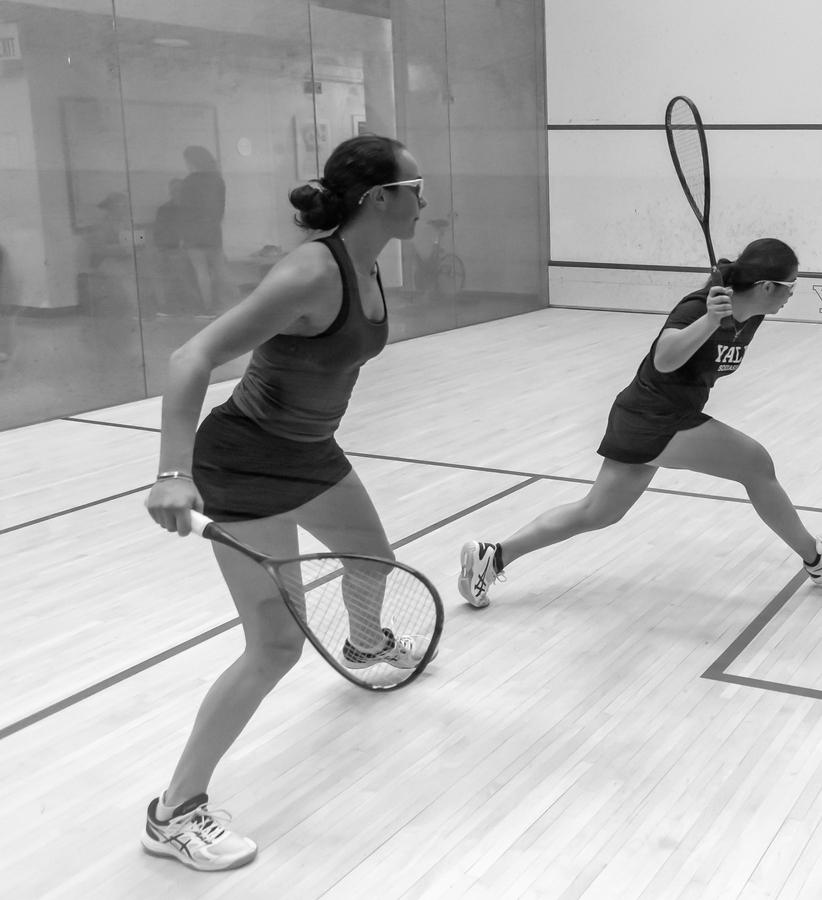
After a weekend of competition, the women fell to Trinity College (18–1, 0–0 NESCAC) and Drexel University (13–4, 0–0 MASC) and rallied to beat Cornell University (9–8, 5–2 Ivy) in the Howe Cup.
On Friday, the women began CSA Championship play against No. 1 Trinity, falling 0–9 to the Bantams.
“I think this weekend of competition taught our team to really believe in the process,” Meghna Sreedhar ’25 wrote to the News. “We had some tough competition but were able to find successful moments in all of our matches by sticking to the game plan and working for every point. My personal highlight of the weekend was watching my teammates put in their best efforts for our final matches of the season.”
On Saturday, the women continued into the consolation set of matches. The Bulldogs fell to the No. 4 Dragons 2–7. The Blue and White fought hard, with Whitney Taylor ’26 and Joy Qu ’26 both losing their matches with close scorelines of 2–3.
On Sunday, the Bulldogs rallied after a long weekend to compete in their final match of the Howe Cup against No. 6 Cornell. The Bulldogs were victorious over the Big Red 5–4. Sreedhar, Mika Bardin ’26, Lindsay Westerfield ’25, Qu and captain Brianna Jefferson ’23 won their matches for the Bulldogs.
“The team faced tough opponents this past weekend, but showed grit to flip the Cornell result from earlier in the season, demonstrating that the more determined team will come out victorious,” assistant coach Tate Miller wrote to the News. “I will always remember watching Joy Qu come back from 10–7 down in the fifth game against Cornell and clinching the match for the Bulldogs.”
Yale women’s squash entered the 2022–2023 Howe Cup as the eighth seed and finished seventh in this year's National Collegiate Women’s Varsity Team Championship. The top five finishers in this year's CSA championships were Harvard (14–1, 6–0 Ivy), Trinity, University of Virginia (13–7, 0–0 MASC), Drexel and Columbia (5–8, 3–3 Ivy).
Last year, the Bulldogs entered the tournament as the fifth seed and finished fourth.
“I am really proud of the team for their tenacity this season,” Jefferson wrote to the News. “We had a lot of setbacks with injuries and such, but I am so glad that we were able to finish strong through nationals.”
Harvard women's squash won this year's Howe Cup. The Crimson has won the CSA Team National Championships every year since 2015, except 2021 when there was no tournament play due to COVID-19.
Looking ahead, the Bulldogs will compete in the College Squash Association Individual and Doubles Championships at the Arlen Specter US Squash Center in Philadelphia, PA during the weekend of March 1.
Contact BETSY GOOD at betsy.good@yale.edu
SPORTS PAGE 10 YALE DAILY NEWS FRIDAY, FEBRUARY 24, 2023 yaledailynews.com
YALE ATHLETICS
Following a close Friday night loss at Penn, the Bulldogs rallied from a 19-point second-half deficit to take down rival Princeton.
YALE ATHLETICS This weekend, the women’s squash team competed in the CSA Team Championships to finish their 2022-2023 team season.
WEEKEND
 // BY CAROLINE PARK
// BY CAROLINE PARK
I went to Montreal recently, for the first (and most likely) last time. One night, I stumbled across a hookah bar that was sort of sunken into the ground. Like some kind of modern-day, 21-year old matchbox girl, I peered inside the cracked windows to see an older man playing a violin inside. He looked at me, watching him, and he smiled, swaying a little more convincingly for my pleasure. And I felt in that moment that I must be pretty, that as he looked at me through the hole in the wall, and I looked at him absorbed in his craft, that he must find great pleasure in performing for me, a pretty young tourist watching him from a distance.
It occurs to me that my indulgence in this kind of saccharine moment of prettiness is perhaps less than noble. Vain, you might call it. As we all know, beauty lies on the inside. In our heightened evolutionary state we should be able, ought to be able, to distinguish from the glitter of the surface and the substance below. But is it really so shallow to crave those eclipses of validation? To chase Pretty instead of the Beauty that beckons beneath? I would be lying if I didn’t relish the pleasure of feeling that I was young and well dressed and attractive. But its sublimity went beyond just the physical calculus. For a moment, he became the entertainer throwing a bit of the sparkle of his spotlight toward me, and I became the anonymous young woman, enraptured by his performance. Perhaps I could remind him of an old lover, a friend from his home country, or just a notable passerby on the street. In any case, I might be Pretty.
IN DEFENSE OF VANITY
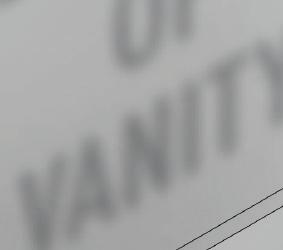
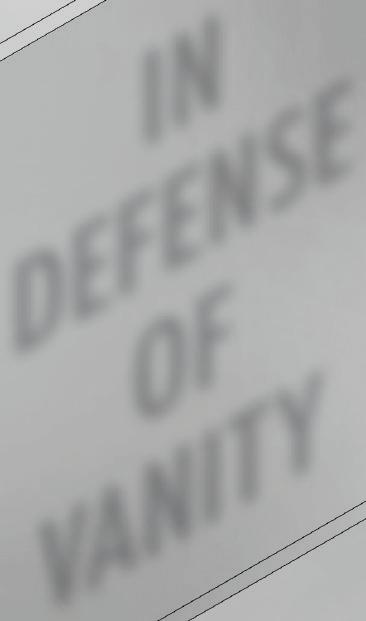
What exactly distinguishes Pretty from Beautiful though? Why search for the ‘beauty inside’ and moralize the aspiration to Pretty as vain? Vanity, inherently, recalls superficiality, shallowness. Where Beauty makes space for the contours of the individual, Pretty is a generalized idea, it exists only in relation to the standards around us. It’s an image for people to fall in love with. It is the fl attened idea of Zoey Deschanel as “Summer”––to know very little about and to idolize. It is the unknowable tourist glittering with youth and foreignness and offering a smile. It is heternormative, rooted in patriarchy, white supremacy, and inherently alluring in its exclusivity and unattainability. And because of this, it feels generally like a moral failing to succumb to the pitfalls of caring about Pretty. If all these standards are arbitrary, racist, sexist, and no indication of the value of a person’s worth, then it makes sense that lookism has been relegated to a moral failing in our collective imagination. Like other -isms in our midst, we seek to overcome them by a collective commitment to
The Good Fortune of Living in Lanman Wright Hall

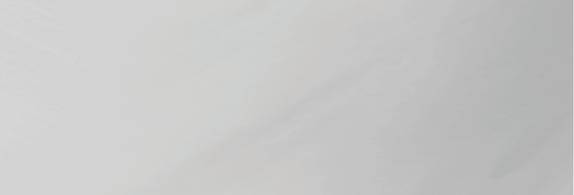



goodness, a joint performance in pretending that looks don’t matter at all: Everyone is Beautiful on the Inside. It seems to me, though, that we all implicitly understand that Pretty is an idea. The more you know about a person, the more they deviate from it. Fundamentally, the more specific the contours of that person in your mind––the more distinct the curve of their nose, the shape of their personality––the further they stray from that singular asymptotic ideal, the idea of who we all want to love, who we all want to be. In that way, the transience of my interaction in Montreal was conditional to my existence in the state of Pretty for just those few minutes. The violinist knew nothing of me, and I knew nothing of him. All we knew was that in that moment of brief interaction, he was exactly who I wanted him to be, and I could be exactly what he wanted me to be, across the picture-frame of that open window.
In explaining the idea of the “White Girl”™, essayist Hilton Als wrote once that “Images are really powerful. People fall in love with images, and as a way of falling in love with someone because they are like an image.” Perhaps this is why Pretty has such appeal. If I could approximate myself as close as possible to Pretty, perhaps I could get more people to fall in love with me on the street. Perhaps if enough people fell in love with me on the street, then it would be evidence that I, too, was worthy of love, attention, adoration.
A few days after I came home from Montreal, a friend of mine sent me a photograph he had taken of me as he watched me watch that violinist that night. To be frank, it was a bad photo. The lighting was poor, and all you can really see is the back of my head in front of that cracked window. As I looked at the photo, I could imagine him watching me watch my violinist. Perhaps he knew that I was flattered by the violinist’s attention, and that I liked the idea that a stranger could be so enamored by just my passing glance. All the same, he saw the moment as beautiful and wanted to capture it. Saw my little vanity, my turn towards the stranger for validation as a beauty
that was worthy of becoming a memento.

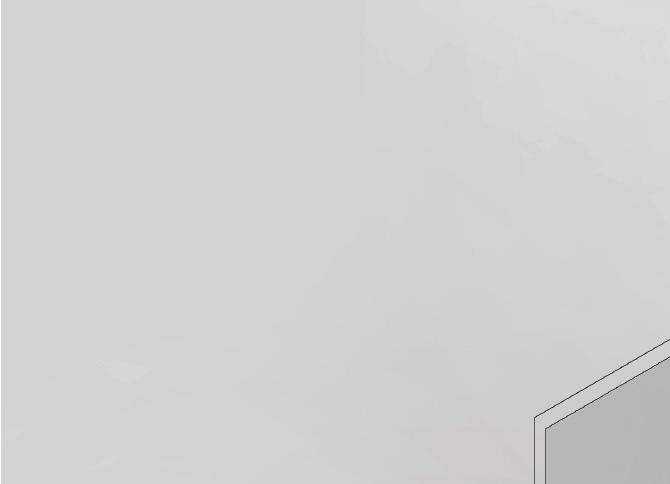
If Pretty is a saccharine sugar high, beauty is perhaps much more mundane. It’s taking a sort of bad photo, and sitting through the hours of getting to know someone, of learning that they always take their compact out to redo their lipstick because they’re afraid they might look undone, and loving them anyway. And in searching for that unreal high of Pretty, perhaps what we really want is to be seen as beautiful. To come to look back on millions of those mundane moments and realize that we are seen and loved. But it seems unfathomable at the beginning of those mundane moments, unfathomable that the person before us might see us in our entirety, or even close to that entirety, and still love us. It seems much easier to forever aspire to an unachievable image of the Lovable than to truly expose ourselves to the world. That path is simple after all - Lose
Five Pounds or Dye Your Hair - if you can convince someone you are worthy of their adoration by the way you look, why not shoot for that goal?
Perhaps we’ve written o vanity too quickly. Pretty is superficial, yes. It requires the flattening of the self into the image worthy of adoration. But isn’t it deeply understandable that you might get addicted to those moments where you can believe that someone might find you good, worthy of love, deeply understandable? Pretty is the glorious, sexy version of the mundane reality of what it means to be seen. The hard work that goes into being Beautiful, the participatory nature of Beauty. You allow yourself to be beautiful to someone, allow them to see beyond the performance of what you think is the closest ideal you’d like to be. In some ways, we’ve prettifi ed vanity, allowing it only to stand for a one-dimensional obsession with-self, a somehow fundamentally feminine narcissism that ought to be avoided. Could vanity, too, be beautiful? Could it be seen instead as an expression of the fundamental human desire to be seen, and to be loved?
After I read Hilton Als’ White Girls, his idea of the White Girl stayed with me for months. I realized that I had spent my entire life grazing asymptotically close enough to the ideal of the White Girl to keep aspiring, but always far enough to visualize each of my complex shortcomings. That vanity, that lifelong aspiration, was perhaps just a desire to convince the average passersby that I was in fact worthy of love, or at least, worthy of letting their gaze linger on my face for just a few seconds more. That instinct hasn’t gone away, the more time I spend in my body. But perhaps I can mold it to a more noble version of vanity. Perhaps that version of vanity could mean becoming more my own color, such that the experience of me might no longer be pleasurable, but irreplicably intense.
Contact CAROLINE PARK at caroline.park@yale.edu .
Do my eyes deceive me? I thought. Maybe this is chocolate.
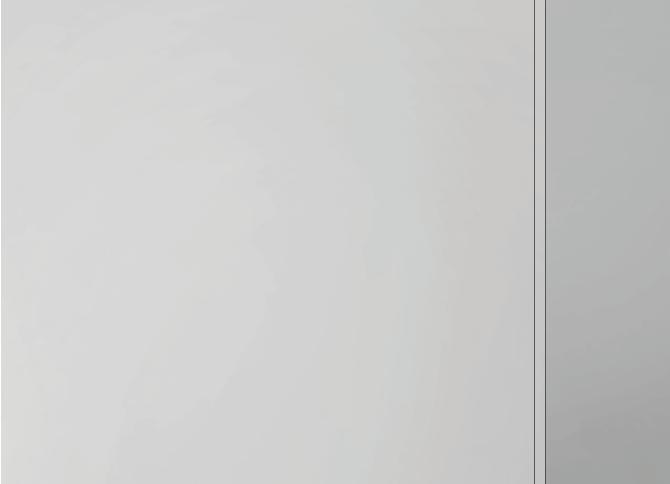
I live on the fourth floor of Lanman Wright Hall on Old Campus, notoriously known as L-dub. At night, I walk up four flights of stairs and climb up a not-so-stable ladder to get to my bed.

Despite the building's notoriety, I love living in L-dub. Why? Because the bonds formed in such close quarters are unbreakable.
My good friend, Devon Sawyer ’26, has the questionable fortune of living on the first floor. When I enter the L-dub courtyard to go to my room, I often find myself in his instead. Our more athletic friends (or maybe our less wimpish ones) even climb through a window to enter Devon’s common room, just for kicks. We stay for hours. That common room is where I learned how to play chess. Oh, and did I mention that his window was egged? Twice?
The physical structure of Lanman Wright Hall has proven perfect for a vibrant social scene. Besides entering a friend’s dorm through the courtyard, you can also hang out in the courtyard itself, where you’ll find a di erent group of equally welcoming people every day. When I walk up the steps and into the courtyard, I’m greeted with a smile and oftentimes a conversation waiting to happen.
And although this is cliché, the less conventionally positive aspects of the living space do in fact strengthen bonds. If you’re squeamish, be wary of the following story. If not, sit back and enjoy the ride.
Last semester, I was at a meal with my roommates, and I hadn't been in our dorm all day. One could imagine my surprise to find out at mealtime that in one of our bathroom stalls (shared by twelve girls) was an actual piece of fecal matter … on the floor. The working theory was that someone, not in their best state, had “missed” the toilet.
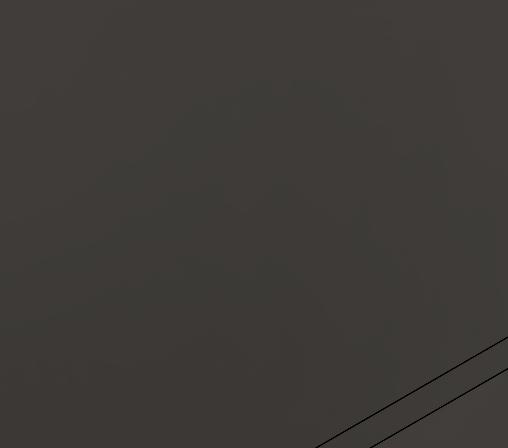






When I arrived back at the building, I felt I needed to see this with my own two eyes. Otherwise, the story of “shit on the floor” was as good as fiction. So I entered the stall, and there it was resting lopsidedly on the tiled floor.
WKND Recommends
Going on a walk in Old Campus.
Exercising a qualitative test, I even leaned in and took a whi . My eyes did not deceive me! Sure, it was gross, but I laugh about it and even admire its absurdity to this day. My floor grew closer because of it. The whodunnit gossip was hilarious, and we had a boatload of fun trying to piece together the “shit on the floor” mystery together at our communal sink.
“I bet it was one of those girls from Entryway E,” said one of my floormates, referring to the other freshmen whose dorm is attached to our bathroom but who are technically not allowed to use it because they're from another entryway. Scapegoating is fun!

In yet another instance of L-dub shenanigans, two Pierson FroCo groups (Pierson and Berkeley frosh live in L-dub) attended a mandatory “fireside chat” with our wonderful FroCos, dean and head of college. The event was meant to be something of a check-in, and we took polls about how we were coping with college life. One of them asked us what surprised us most about life at Yale, and one of the multiple choice options was L-dub. When asked to explain why he had chosen this answer, one of my peers said, “There was bloodshit in the toilet!”
“Bloodshit?” repeated our administrators in fascination and humored shock. “You get more ice cream for that.”
It may be gross, but “bloodshit” became our collective joke of the night. Have you ever bonded with your head of college like that? I didn't think so.
Yeah, L-dub isn't the Ritz. We don't have much space or hygiene or high-maintenance class. But we do have friendship, humility and the ability to laugh at ourselves. You call it a last resort, but I call it good fortune.
I live on the fourth floor of Lanman Wright Hall. At night, I walk up four flights of stairs and climb up a not-so-stable ladder to get to my bed. And I wouldn't want it any other way.
Contact SAHAR TARTAK at sahar.tartak@yale.edu .
YALE DAILY NEWS FRIDAY, FEBRUARY 24, 2023 yaledailynews.com PAGE 12
// BY SAHAR TARTAK
Beauty in Black Resistance
SITTING PRETTY
“Sitting pretty” is just that. three beautiful, successful Black women sitting still and looking pretty.
It’s a celebration of Black joy and beauty at Yale.

I want you to get lost in their hair and fall in love with their curls. I want you to dive deep into the texture of their skin and adore how the flowers frame their faces.
I want you to just sit there, look pretty, and set your work aside to read through this issue.





I loved making this piece. I hope that you can feel the love, too.


FRIDAY, FEBRUARY 24, 2023 //
DE
A SPECIAL ISSUE FOR BLACK HISTORY MONTH
ANGELIQUE
ROUEN
BLACK HISTORY MONTH SPISSUE
Welcome to the Beauty in Black Resistance special issue!
Welcome to the News’ special issue celebrating Black History Month! This special issue is meant to be for Black people, from Black people, showcasing the unity of the African diaspora and the beauty in Black resistance. I am incredibly excited to amplify the voices of Black students, faculty and professionals through profiles, personal essays, poetry, podcasts, illustrations and photography.
I hope that this special issue serves as a form of Black resistance, appreciating the intersectionalities that come with being a Black person in America while prompting change in the world around us. A special issue
cannot and will not possibly cover the nuances of Blackness, but I wish for it to mobilize change. One special issue is not going to address the diversity crisis at the News, nor will it mend the relationship between the News and Yale’s – as well as New Haven’s — Black community. This special issue, however, is a way in which the underreported and underrepresented Black communities on Yale’s campus and in New Haven can unapologetically celebrate themselves. It also serves as a reminder to the News that no, we are not doing a good enough job at recruiting Black reporters. If we can
What’s a spissue for?
When I first arrived on campus, I knew nothing about journalism. I had started writing op-eds only a few months prior, and I was generally excited by the prospect of addressing any given publication’s readership with my opinions. So naturally, I started writing columns for the YDN. Some of them were decent, most of them were bad, but all of them gave me the chance to share my ideas with readers and start critical conversations about Yale.
When I became a sta columnist, I sought to focus on issues of collective responsibility, of what we owe to one another and the world as Yalies. I wrote about racial injustice and class stratification as those issues presented themselves at Yale and across the country. In hindsight, the column was a bit heady, and I was never really able to cover everything that I set out to. I realize now, especially, that I never truly turned my focus to one of the most important institutions on this campus, one whose legitimacy I took as a given: the Yale Daily News. The more I think about it, though, the more I realize that this student newspaper is quite reflective of the same problems of race that plague this entire university.
Every year that I have been on this campus, I have been asked to contribute to the Black History Month “spissue” of the YDN. The first time it happened, I was thrilled to be given the opportunity — it was a chance to speak candidly about what it’s like to be a Black Yalie. So I wrote eagerly about what I had learned during my five months in college, and I shared that piece in earnest once it ran.
The second time it happened, I was much less enthused about contributing. I had just finished a semester co-editing the News’ opinion section, and I became aware of two disappointing facts during my term. First, very few Black Yalies contributed to the News, and second, very few Black Yalies wanted to contribute to the News. Forced to step back and examine why this was the case, it didn’t take long to realize that the News was both unwelcoming to Black writers and unwilling to take meaningful steps to change that.
One could speculate why: the News’ has a long history of covering Black communities in deeply problematic ways; it has a reputation as a cutthroat, time-intens ive and occasionally toxic organization; and, as far as I’m aware, dedicated e orts to recruit Black students to the YDN are simply non-existent.
That speculation is besides the point, though, because the truth remains that the Yale Daily News has a dearth of Black writers and editors. The four Black editors my year was considered a record. So I met the spissue of my sophomore year with cynicism, only speaking briefly on a YDN podcast about the same diversity problems presented here.
This is my third time around the block, and I think it’s safe to say that I’m completely disillusioned. For yet another year, the YDN has decided to place the burden of spinning up an entire special issue on the backs of its handful of Black contributors (and anyone else they can sleeze into writing). Once this spissue is done, the effort to recruit Black contributors will likely also be done (if history is any guide). So, to me, this spissue is a farce.
It is Black Yalies being given their one day in the Sun to perform and explain their Blackness to the YDN audience, and remind them that, yes, Black people do go to this school and, yes, Black people may occasionally have interesting things to say. It is the YDN’s chance to make a pro-diversity posture with as little e ort as possible. This is not to disparage the editors leading these e orts. I’d like to think that most of them are genuinely interested in making the YDN a more diverse place. Nor is it to disparage the entire concept of a special issue (or any diversity effort); a performative e ort is better than no e ort. A spissue is a great way to spotlight Black voices, but in the absence of any more meaningful attempts at change, it amounts to nothing more than a cheap trick. It’s a way to claim progress without actually making any.
I am somewhat encouraged by the progress that the YDN has made in recent years. It seems that the managing board has gotten more diverse, and the News even has diversity positions now. All of that is quite cute, but I’m not one to hold my breath. Every year, YDN leadership promises to commit to diversifying its sta , and that promise never materializes. The promise of diversity itself is a false one as well, it will not necessarily address the deep-seated issues the YDN has in relating to Black communities.
So if you’re a Black student on campus, avoid spissues and consider writing elsewhere.
CALEB DUNSON is a former Opinion Editor and current Opinion Columnist for the News. Originally from Chicago, Caleb is a junior in Saybrook College majoring in Political Science .
recruit and amplify Black voices during the month of February, Black creatives could and should be supported to contribute throughout the academic year. For now, we can think of this as a Black YDN takeover.
I encourage you to acknowledge the deficiencies in special issues and to learn about the flaws in diversity, equity and inclusion. Read about the Dixwell Avenue’s Underground Railroad, immortalizing the oral histories of New Haven residents. Please read the views and works of poetry dedicated to both celebrating and questioning Blackness. Gaze at photographs telling the story of margin-
alization. Listen to podcasts about the impact of Black farming.

I would like to acknowledge the contributions of those outside of the News. I thank you for submitting content for the first time, and, most importantly, I thank you for trusting us with your words. Your time and e orts are seen and valued. You have always had a voice, and I am glad to have handed you a microphone and speaker.
Thank you to the members of the News who made this happen, including reporters, desk editors, copy editors, production and design editors, audience editors, photogra-
phers, illustrators and management. Thank you to our esteemed diversity, equity and inclusion co-chairs — Anika Seth, Paloma Vigil, Sophie Wang and Yash Roy. This issue would not be possible without your hard work and commitment. We welcome any and all feedback! Feel free to contact us at editor@yaledailynews.com, or email me individually at the email address below.

ALYSSA MICHEL is the editor for the Beauty in Black Resistance Spissue and is also a Podcast editor for the News.
Message to Black Yale
“When [one] is exercising extremism in defense of liberty for human beings, it’s no vice. And when one is moderate in the pursuit of justice for human beings, I say he’s a sinner.” That was Malcolm X’s message to the students of Oxford University in 1964. On this day, the 58th anniversary of his martyrdom in 1965, Malcolm’s message is as poignant as ever. Malcolm was speaking at an Oxford Union debate in which students were discussing the controversial words of Senator Barry Goldwater from that year’s presidential election: “I would remind you that extremism in the defense of liberty is no vice. And let me remind you also that moderation in the pursuit of justice is no virtue.” While Malcolm argued in favor of the debate resolution, his speech certainly wasn’t an endorsement of Goldwater’s neoconservatism. His speech was an endorsement of revolution, which, at the time, was sweeping Africa, Asia, and Black America too. It’s speeches such as these that I believe are needed in 2023. Yale students, particularly Black Yale students, are in need of Malcolm’s message in 2023. In my view, we, Black Yalies, are thoroughly moderate, thoroughly bourgeois. Perhaps this Black History Month, we can begin to shake o the tendency of political quietism. On February 3, 2023, we, Muslim Yalies, had the pleasure of hearing the words of Dr. Bilal Ansari at Jumu’ah prayer. Dr. Ansari is a Black Muslim, a New Haven native, the Assistant Vice President for Campus Engagement at Williams College, and Williams’ fi rst Muslim chaplain. In his khutbah, he argued that Muslims have a religious obligation to pursue justice, to be revolutionary, and to embody the emancipatory spirit of the Islamic tradition. He connected this to the recent murder of Tyre Nichols. Dr. Ansari was challenging Yale’s Muslim students to have the courage to fight the system that murdered Nichols. And I couldn’t agree with him more, I believe that our faith compels us to do so.
Nichols was murdered by five Black police officers — fellow Africans, acting as agents of America’s repressive neoliberal order. Although we Yalies are not out in the world directly enacting such violence, we are certainly indirectly participating in it given our position in this institution. Yale has an abundance of connections to imperialism and global capitalism, but we can see the exploitation and structural violence enacted by Yale right here in New Haven. Yale’s relationship to New Haven is almost neocolonial. Since the presidency of Richard Levin, Yale has been depleting New Haven’s resources, appropriating its land, and pushing out its residents, all with the backing of its private police force. New Haven, particularly Black New Haven, is treated as if it were a shantytown in need of being systematically cleaned up, “redeveloped,” and resettled.

While Yale students aren’t responsible for creating and imposing this system on New Haven and the world, we are complicit in perpetuating it, especially when we’re not involved in trying to overturn it. I fi nd it quite disappointing that solidarity between Black Yale and Black New Haven is minimal, that we have almost no connection to the masses in this city or elsewhere in the world.
Black Yalies seem more interested in integrating into the existing social order rather than changing it. Black entrepreneurship, Black consulting, and Black finance are of the highest concern. Blackness is only understood in cultural terms and divorced from political economy. Collective action is superseded by opportunistic self-interest. One would get the impression from Black Yalies that the Black liberation movement of the ’50s, ’60s, and ’70s was fought in order that Black people could intern at McKinsey or Bain Capital with white people, in order that Black people could be equal exploiters in this settler colony called America. In Malcolm’s words, “these Negroes aren’t asking for no nation, they’re trying to crawl back on the plantation.”
I want no part in perpetuating the system that traces its lineage from Elihu Yale and the British East India Company to Goldman Sachs and the other malignant institutions of today. None of us should want to share in that. We should be doing everything we can to put an end to the injustice that takes place here and throughout the world. It’s time to stop worshiping the Black celebrities, the Black politicians, and the Black billionaires. It’s time to stop contenting ourselves with diversity, equity, and inclusion. It’s time to stop seeking representation in a genocidal system that historically has and contemporarily is oppressing our people. It’s time to organize against the system.
Malcolm’s final words from the Oxford Union speech continue to ring true: “In my opinion, the young generation of whites, blacks, browns [...] are living at a time of extremism. A time of revolution. A time when there’s got to be a change. People who’ve been in power have misused it and now there has to be a change and a better world has to be built. And the only way it’s going to be built is with extreme methods. And I for one will join in with anyone — don’t care what color you are — as long as you want to change this miserable condition that exists on this earth.” I hope that from this Black History Month onward we desire to follow the example of Claudia, Malcolm, Fannie Lou, Ella, Stokely, Gloria, Kathleen ’84 LAW ’89, Angela, Assata, and others. I hope we aspire to organize, to engage in political struggle, to be a part of the solution, and to change the conditions that exist in this world.
Please join the Yale University Chaplain’s O ce for the 2023 Dr. Betty Shabazz & Malcolm X Memorial Lecture on Monday, March 6, 2023 at 6:30 p.m. in SSS 114.
CRAIG BIRCKHEAD-MORTON is a junior in Silliman college. He is the Student Organizing Liaison of the Yale College Council. Contact him at craig.birckhead-morton@yale.edu.
PAGE S2 YALE DAILY NEWS FRIDAY, FEBRUARY 24, 2023 yaledailynews.com
GUEST COLUMNIST CRAIG BIRCKHEAD-MORTON
Editor’s note: The content printed in the Black History Month Special Issue can also be found online at this QR code with other content that was not printed in this print issue. EMMANUEL AMOAKOHENE/CONTRIBUTING ILLUSTRATOR
grow community:” How urban agriculture has sprouted in New
BY ALYSSA MICHEL PODCASTS EDITOR
Last month, Dishaun Harris started selling containers of his organic microgreens at New Haven’s City Seed Indoor Winter Market.

Harris, a New Haven native, created the urban agriculture company Root Life after working as a farmer and environmental educator at Common Ground High School for three and a half years. Harris now has over 10 years of urban farming experience, which he uses to manage community gardens across New Haven. In these gardens, he grows produce for his Community Supported Agriculture subscription programs and teaches youth and community members how to start gardens of their own. New Haven has over 50 community gardens.
Last year, Harris started a garden behind the Faith Temple Deliverance Center on Newhall Street — he also currently manages the Armory Community Garden on County Street. Harris explained that community gardens provide increased access to fresh produce while serving as a means to strengthen and build community within New Haven.
“They allow [us], in a lot of spaces, to address food apartheid issues,” Harris said to the News. “So getting healthy food to local residents in ways they would not be able to get otherwise because it’s just not in their neighborhoods, their areas, their cities.”
The term, “food apartheid,” as opposed to “food desert,” highlights
the racially discriminatory practices that underlie a lack of access to food in certain communities.
Unlike a desert, Harris explained, apartheid is an unnatural, societally-driven occurrence.
Robert Peck, who is also known as the “Hood Farmer,” began urban farming in Connecticut after participating in an AmeriCorps program in Florida. He said that the effects of food apartheid in Tallahassee mirror what is happening in his hometown of Bridgeport.
Peck told the News that community gardens and unofficial “guerilla gardens,” where residents grow on public land, are crucial to the greater Bridgeport community.
“Especially with the way things have gone in the supermarket, that just allows people to have another space and it’s almost like stock when it comes to food,” Peck said. “People know that they can go to this space and tap in the way that they do and still produce something for their families.”
Through Hemp Milk & Honey, a Black-owned natural farm business based in Bridgeport, Peck aims to help people start their own gardens at home. He said he soon plans to transition the business into production farming, growing produce for sale.
When she moved to New Haven for her residency program at Yale in 2017, Hana Ali was searching for low-cost exercise programs similar to ones she attended in New York during medical school. Brought to the Armory Community Garden for discussions about
starting a similar exercise program in her neighborhood, Ali quickly began gardening there. Ali said she soon found community and an “incubator for ideas” in urban gardening.
“We grow food and we grow flowers and natural medicines but then we also grow community and we grow ideas,” Ali told the News, “If there’s an older community member who you haven’t seen in a couple weeks, we know to go check in on them because we expect to see them there.”
Community members can support small farmers through CSAs, which are subscription services that guarantee consumers fresh produce regularly through the summer and provide farmers with the finances to get the growing season started.
Soon, Root Life will offer jams, juices and dried herbal blends at CitySeed’s market through their spring CSA program.
Contact ALYSSA MICHEL at alyssa.michel@yale.edu.
Editor’s note: This article was written in conjunction with the latest episode from the Yale Daily News’ Black History
Month
Special Issue.

The episode titled “Black Farming: It’s in Our Blood” discusses urban agriculture and community with Root Life owner, Dishaun Harris.
New Haven churches and the Underground Railroad
BY COLLYN ROBINSON STAFF REPORTER
For over 200 years, Varick Memorial A.M.E. Zion Church and Dixwell Avenue Congregational United Church of Christ have been cornerstones of the New Haven community, even serving as safe havens for enslaved people who fled the south on the Underground Railroad.

Varick Memorial Church was founded in 1820, standing as the third-oldest African Methodist Episcopal Zion Church in America and the oldest Black church in New Haven. Dixwell Congregational Church, also founded in 1820, is the oldest Black congregational church in the world. It was originally located at the end of Temple Street near the modern-day expressway, but moved to Dixwell Avenue in 1860. About 100 years later, in 1969, it moved up two blocks to a space next door to the Dixwell Community House, also referred to as the Q House. The Varick Memorial Church, which remains in its original location, still contains the overlook above the church parish that several educators and community members said was the place where enslaved people were hidden.
“Visiting this site was bittersweet,” said Marcella Monk-Flake, former parishioner at the Varick Memorial Church. “The hideaway was too low to stand up in, and seeing it made the horrors of enslavement that much more real
for me. I felt a need for reverence, because to me it was a sacred place. I was only there for a brief moment, and although tears filled my eyes, I could only think of the strength and resilience of my people.”
The News spoke with New Haven community members about the Underground Railroad and its relationship to Dixwell Avenue. Conversations pointed to a comprehensive oral history, as well as some archival documents preserving the rich legacy of the two churches.
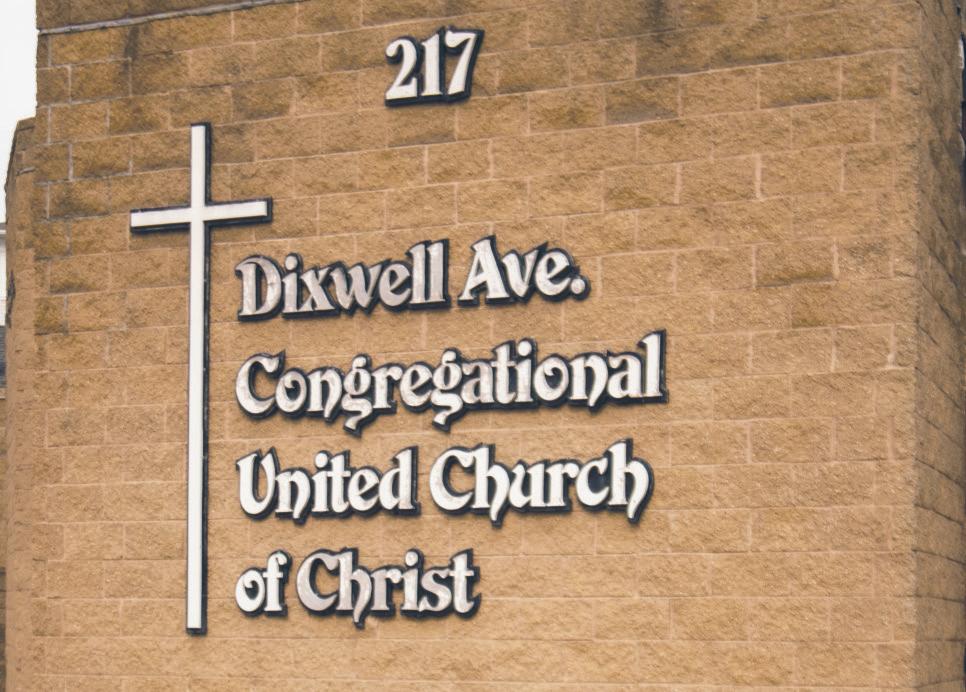
Varick Memorial Church Pastor Kelcy Steele said overall there are limited archival documents about the history of the church in relation to the Underground Railroad, and about enslaved people in general. Steele explained that this is why oral history has become the most reliable source of information with regards to the history of enslaved people.
“A lot of times our history was not preserved,” Steele told the News. “Things were taken home, put in the attic, thrown away.”
New Haven native MonkFlake, who is now an educator, spoke about the time when a previous pastor at the Varick Memorial Church first gave her access to view the site where enslaved people used to hide while on their journey along the Underground Railroad. Although the hideout was intact, she said the structure was still unstable. She described the place as having a small window
with a view that looks across Dixwell Avenue. Access to the space is now even more limited after a fire in the parish house a few years prior.
Motivated by her love of history, Monk-Flake said that she first came across the information about New Haven’s ties to slavery, and more specifically the Underground Railroad, on her own. That history, she said, was not taught in school.
The Underground Railroad was a network of safe “stops” for enslaved people making their way north to free states and Canada.
The system is called the Underground Railroad because freedom-seeking enslaved people had to remain invisible and out of public view — as if they had gone underground — to avoid capture.
Private homes or churches would host the formerly enslaved person until they could move on to the next stop. Two of such sites along the railroad were Varick Memorial Church and Dixwell Congregational Church.
Pastor Steele said that wellknown abolitionist Harriet Tubman, who was involved in the Underground Railroad, was a follower of the African Methodist Episcopal Zion Church denomination which Varick Memorial Church is a part of.
Pamela Monk-Kelley, educator and sister of Monk-Flake, said she also found out about New Haven sites of the Underground Railroad through oral history. As a person who visits churches frequently, she
learned about this history from Varick community members and churchgoers. She mentioned that when Varick holds anniversary celebrations, members typically discuss the history of the Underground Railroad and the church. While she did learn about New Haven history at school, she said that her current understanding of slavery and its ties to New Haven was not something that was taught in her classes.
New Haven Board of Education representative Edward Joyner said that he was teaching the history of the Underground Railroad at Hillhouse High School before he even learned about the specifics of railroad and its relation to New Haven. He told the News he learned this history by living in New Haven and building relationships with the pastors at the Varick and Dixwell churches.
“By going to church there, from time to time, [the topic of the Underground Railroad in New Haven] would come up,” Joyner said.
Dixwell Congregational Church pastor Frederick Streets
DIV ’75 was a student at the Yale Divinity School and an intern at Dixwell Congregational Church when he first found out about this history. He said he believes this knowledge is important and should be passed down from generation to generation.
“It talks about resilience, people Black and White, but
certainly about the enslaved people, their resilience, their creativity, their intelligence . . . it’s a part of American History and not to have it known or understood is a blind spot,” Streets said. “Imagine leaving South Carolina, Mississippi, [or] North Carolina often on foot or horseback and making your way 1000 to 1500 miles to freedom when you have slave catchers on the same route finding runaway enslaved people and taking them back? It was a very dangerous enterprise. This is a real story of the resiliency of humanity.”
Steele echoed the same sentiment, adding that passing on information generationally is the best way to preserve history. He said that there are “some things a textbook doesn’t capture and school doesn’t teach.”
Monk-Flake told the News that she thinks that the history of the Underground Railroad in New Haven should always be taught in school.
“It’s criminal that it’s not taught and that it’s not taught in its entirety,” she said. “I just think that this history is so complex and tells such a rich story.”
Varick Memorial A.M.E. Zion Church is located on 242 Dixwell Ave. and Dixwell Avenue Congregational United Church of
Christ is located on 217 Dixwell Ave. Contact COLLYN ROBINSON at collyn.robinson@yale.edu.
SPISSUE PAGE S3 YALE DAILY NEWS FRIDAY, FEBRUARY 24, 2023 yaledailynews.com
“We
Haven
COURTESY OF DISHUAN HARRIS Amid the growth of community gardens across the state, urban farmers discussed food apartheid.
Dixwell Avenue Congregational United Church of Christ is located on 217 Dixwell Ave.
COLLYN ROBINSON/CONTRIBUTING PHOTOGRAPHER Varick Memorial Church and Dixwell Congregational Church have a rich history as sites that served as safe havens for freedom-seeking enslaved people
COLLYN ROBINSON/CONTRIBUTING PHOTOGRAPHER
THROUGH THE LENS
In my final few months at my predominantly white high school, I wanted to discover the stories the administration chooses not to preserve. Discarded and looked past, much of Andover’s institutional memory turns to smoke with every graduating class that departs.
My attempt to return the narratives of my former peers of color to Andover’s campus proved fruitless, and the failure had me considering a new question: what stories will be told on my behalf? Will they be told at all?
A new approach led to this photo series capturing four amazing, marginalized student leaders in the Trustees Room – a place the school bars students from entering. I originally shot each frame in color, but eventually decided to convert them to black and white. With the lack of color, I ask each viewer to judge what will be the fate of my work and legacy in the institution. Is it timeless and irremovable? Or have the emotions of joy and sorrow we often associate with color been stripped away?





The piece not only captures the perpetual plight of Andover’s institutional memory but due to its impermanence, becomes another story that meets the same tragic fate.
I entered this project with a question, and beautifully, left with another that I have yet to answer.
Photos and words by Kris Aziabor.
PAGE S4 YALE DAILY NEWS FRIDAY, FEBRUARY 24, 2023 yaledailynews.com
Ijeoma Opara and the power of health advocacy
BY KAYLA YUP AND VICTORIA VILTON STAFF REPORTER AND CONTRIBUTING REPORTER
At a young age, Ijeoma Opara realized that speaking up for herself could save her life.
Growing up, she witnessed the health inequities faced by her mother and father, who were frequently in and out of the hospital. Her advocacy stems from the belief that if her parents had been able to advocate for themselves to receive proper medical care, they would still be alive today. Opara — an assistant professor of social and behavioral sciences at the Yale School of Public Health — is on a mission to reduce health disparities faced by Black people.
From leading the Substances and Sexual Health Lab at the School of Public Health to running the Dreamer Girls Project for Black teenage girls, Opara devotes herself to advocacy, research and outreach. She invited nine-year-old Bobbi Wilson on a Black female scientist led tour to help her heal from a viral profiling incident, where Wilson’s neighbor called the cops on her while she was protecting trees from lanternflies. She created the Activist-in-Residence Program at YSPH. When she joined Yale in July of 2021, she knew it would not just be a win for her, but for her community.
“I often reflect on my own positionality, my own identity as a Black woman, as somebody who’s a Yale professor who grew up in an urban under-resourced environment,” Opara said. “When I was a child, I never foresaw that I would even get to this level of education or even this career of being a professor at Yale — it wasn’t even something that I dreamed about because I never saw anyone that looked like me accomplish these things.”
Opara was raised in a predominantly Black area of Jersey City, New Jersey, by parents who immigrated from Nigeria. Growing up, she recounted wanting “to be everything”: a lawyer, a physician — Opara was an advocate from childhood, with a love for defending and debating people.
She was the complete opposite of her mother, who Opara described as “timid” and “submissive.” Unlike Opara, her mother felt that she did not have the power to advocate for herself. She didn’t talk back to her doctors or ask questions. She believed the doctors knew everything.
Opara spent most of her childhood dealing with her mother’s illness, as her father worked two jobs,
one as a security guard and one as a child and family state worker. Her mother went back and forth from the hospital, being blind and paralyzed from her condition. When Opara was 17, her mother passed away from diabetes complications.
“People shouldn’t be dying from diabetes at 46, but she did,” Opara said. “I blame that a lot on racism and we see this today, that Black people fare worse when it comes to diseases like diabetes, heart disease, et cetera … racism is a public health issue. Racism kills, and racism can be done by simply ignoring your Black patients or not acknowledging their fears or not acknowledging their concerns, or not being culturally competent enough to be aware of [the need to] reach this patient through a different lens.”
As immigrants, English was not Opara’s parents’ first language. They did not receive guidance on how to prevent chronic diseases or how to advocate for themselves in front of doctors. They didn’t know how to navigate the healthcare system. The medical system did not give Opara’s mother the help she needed to not only prevent, but to properly treat diabetes.
When Opara was 23, her father, who also had diabetes, passed from a heart attack at 57 years old. Before he died, he told Opara that he didn’t care what she wanted to do as long as she had an impact on the world. To this day, Opara follows her father’s advice.
“I was constantly researching ways to be healthy, questions to ask my doctor and unfortunately, my parents had to die for me to know this,” Opara said. “I don’t want people to go through that. I want us as a healthcare system to be more aware of how intimidated patients are, especially black patients, when it comes to medical care.”
Opara knew that whatever she did was going to be health-focused. She earned her bachelor’s degree in psychology and then a master’s of public health from New York Medical College. Then she got her master’s of social work from New York University, followed by nearly three years as a youth and family social worker.
As a therapist, she worked in an agency for Alternatives to Incarceration, which is an alternative punishment to time in prison or jail given to a person who commits a crime. She spent sessions meeting her clients at their level, inviting them to open up to her in whatever context they felt comfortable, whether that was on a quick drive to a train station or in a booth at McDonald’s.
As she worked with mostly Black and Hispanic girls in New York City, she noticed common challenges they faced around engaging in substance use and sexual risk behaviors. They had trouble managing and identifying healthy relationships and lacked support at the community level. Opara realized the importance of contextualizing Black lives in medicine. A person’s intersecting identities can impact a person’s health, their risky behaviors, how the world views them and their related coping mechanisms.
Drawing on her personal experience as a woman affected by the poor health of Black communities too, Opara realized that she was being pulled towards public health research.
“I wanted to be able to combine my public health background, but also my social work background to be able to be a professor and have this interdisciplinary lens to issues like substance use, sexual health and even mental health — all these issues that impact youth of color uniquely,” Opara said.
Opara earned her doctoral degree in family science and human development from Montclair State University. Now at YSPH, having founded the SASH Lab, Opara’s research targets the prevention of HIV/AIDS, sexually transmitted diseases and substance use among urban youth.
Opara investigates what positive factors can be developed in youth to achieve better health outcomes for youth of color. This may be acknowledging ethnic pride in community, connecting youth to their neighborhood and empowering them through this level of social support. Positive attributes may be honed through programs, such as encouraging young Black youth to have pride and joy about being Black.
Opara’s work as a therapist aided in her empathetic understanding of the difference between human lives and statistics and in her present research, she continues to implement what is called “Community-Based Participatory Research,” or CBPR: a method of study where researchers and community members operate equally in the research process.
In CBPR, trust and comfort are key. This research method is a way in which researchers like Opara are given the unique opportunity and responsibility to begin restoring trust between the historically marginalized and the research field. Opara pursues CBPR with urban
youth to create race- and gender-specific interventions for Black girls.
“Black people have a historical mistrust of researchers, as they should, because of the way that they’ve been taken advantage of and abused for generations,” Opara said. “CBPR was created as a way to bridge this gap between academics and community members, but even deeper than that, too, we’re working with the community members to solve things that they are seeing as problems and to do it in a way that is meaningful to them being as transparent as possible, literally having them have a seat at the table.”
Opara teaches a popular class on CBPR at YSPH. Sitara Weerakoon, a postdoctoral fellow in the SASH Lab, frequently hears students call it “one of the best” courses they’ve taken at YSPH. Weerakoon described Opara as someone who cares deeply about her community, advocacy and mentorship. Opara received a Distinguished Student Mentoring Award from YSPH in 2022.
“She’s so funny and positive and optimistic and bright,” Weerakoon said. “Not only is she a superstar on social media, but she’s just as down-to-earth and welcoming and personable in person.”
Emmanuella Asabor MED ’24
GRD ’22, a graduate student in Opara’s lab, described her as “the kind of scholar and leader [she wants] to be.” Asabor highlighted not just Opara’s ambition and drive but her awareness and transparency in researching the challenges that uniquely affect youth of color.
Opara feels a commitment to helping youth of color, not just because of her own experiences, but also because she recognizes the importance of displaying just how possible it is for them to gain a seat at the table. The visibility of a Black women carrying out valuable research is something that will push more youth of color to realize that they could one day hold these types of positions too.
Opara never had opportunities to go on college tours or imagine herself at an Ivy League school as a teenager. Now here, she wants to create a space for Black girls to feel comfortable in institutions like Yale. Ultimately she hopes to strengthen the pipeline of Black youth to the field of public health research.
Opara invites Black girls to Yale every semester to see her lab, meet her graduate students and get a taste for the field. The first group of girls invited were through her research-community partnerships in urban communities in New Jer-

sey — such as Paterson, East Orange and Newark — which are all predominantly Black and Hispanic. Opara also does outreach work in New Jersey, hosting community health events around substance use, mental health and HIV prevention.
“I wanted to be in a field where I can educate the next generation of public health researchers so that they can understand what it means to be culturally competent, to work with girls of color, specifically Black girls,” Opara said. “So acknowledging their strengths, acknowledging what are the beautiful things of being Black and being a girl in society and [asking] how can we foster this level of strength and infuse that in prevention?”
One of Opara’s prospective projects is a conference where Black girls can come to Yale and get exposure to STEM and public health related fields. This would be a space where Black girls could come from all over the country together in sisterhood and obtain mentorship and learn about careers centered around STEM and public health. Her even bigger vision is to have a research center for public health issues related to Black children. This center would be able to produce evidence-based programs to support Black youth.
Trace Kershaw, chair of the department of social and behavioral sciences at YSPH and one of Opara’s faculty mentors, lauded her brilliance, innovation and ability to mobilize her ideas to conduct research that has large community and social impact. According to Kershaw, she integrates scholarship and theory while also listening to the participants and communities which she serves.
Howard Forman, another of Opara’s faculty mentors, called it a privilege to be in “her orbit.” Describing Opara as “an extraordinary person,” he recognized her willingness to go above and beyond her job description in order to elevate even a single person.
“She’s a reason why you come to Yale, either as a faculty member or as a student,” Forman said. “Because she is the best of us and she brings both scholarship to an area that needs more investigation as well as providing solutions to challenging issues that really affect all of society and particularly urban areas.” The Yale School of Public Health is located at 60 College St, New Haven, CT 06510.
Contact KAYLA YUP at kayla.yup@yale.edu and VICTORIA VILTON at victoria.vilton@yale.edu .
SPISSUE PAGE S5 YALE DAILY NEWS FRIDAY, FEBRUARY 24, 2023 yaledailynews.com GIRI VISWANATHAN/PHOTOGRAPHY EDITOR
From witnessing injustices faced by her parents to working as a therapist, the YSPH assistant professor’s life experiences inspired her mission to reduce health disparities faced by Black communities.
BLACK HERITAGE MONTH
POETRY SUBMISSIONS

SACRIFICES
BY SYDNEY MCCORD
My mother always wanted a girl, so much so that she bore two boys first, so much so that she nearly died during her second labor, so much so that she had me. Some days I wonder what made her desire so strong. Then I realized, maybe she just wanted someone to understand.
Contact SYDNEY MCCORD at sydney.mccord@yale.edu .
ZAWADI
ZAWADI KIGAMWA/CONTRIBUTING ARTIST
HOMAGE TO THE BLACK MATRIARCH

BY MEARA BROWN
Strong in her stance She mustn’t falter
For there is no room for weakness
fight we must
For our rights
For our future
Envious they are of her curves and hips
Not knowing her struggle
Phenomenal woman she is
For she carries the weight of the world
Shoulders tired from the burden
Yet no break is allotted
So she su ers quietly
Until finally, she uses her voice
But when she does, she’s labeled angry
And once again she is silenced —
Or so they thought
Phenomenal woman she is
Receiving hate in every which way,
But she continues
“YOU WILL NOT SILENCE ME” she screams with a child on her hip
For she is a phenomenal mother
Only God knows how tired she really is
How bad it hurts
How bad it bleeds
But she must continue
For she is a phenomenal woman
There is no room for giving up
When you have the world to conquer
And a child to feed
A system to break
Living in fear of her seed’s future
No — there is no room for giving up
She must continue
Only after she is gone can she truly rest
But until the war is won, she is a soldier issuing a battle cry
A cry for change, a cry for help, a cry to be treated like the human she is
A cry for everybody to get the fuck out of her way
And through these cries
She will continue
Yet beneath the raging call to arms is a spirit
A spirit so strong and so fierce —- unbreakable
Bendable she is, but breakable she is not
For she is Phenomenal
Phenomenal woman, that’s me.
Contact MEARA BROWN at meara.brown@yale.edu .
SISTERHOOD
BY SYDNEY MCCORD
Wider than the hips of my ancestors and deeper than their oceans is the love between me and her.
A love that only we can understand, between me and her, her and me, and all of us.
We are a sacred place — a community drenched in sorrow and shrouded in rage — a garden where we’ve planted flowers and bulbs that we nourish alone
ARTIST

PAGE S6 YALE DAILY NEWS FRIDAY, FEBRUARY 24, 2023 yaledailynews.com
Contact SYDNEY MCCORD at sydney.mccord@yale.edu . KIGAMWA/CONTRIBUTING
EMMANUEL AMOAKOHENE/CONTRIBUTING ARTIST








 BY TRISTAN HERNANDEZ STAFF REPORTER
BY TRISTAN HERNANDEZ STAFF REPORTER






















 BY SPENCER KING STAFF REPORTER
BY SPENCER KING STAFF REPORTER

















































